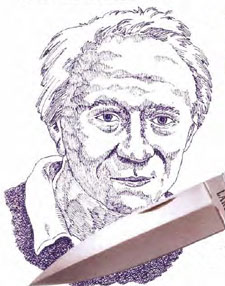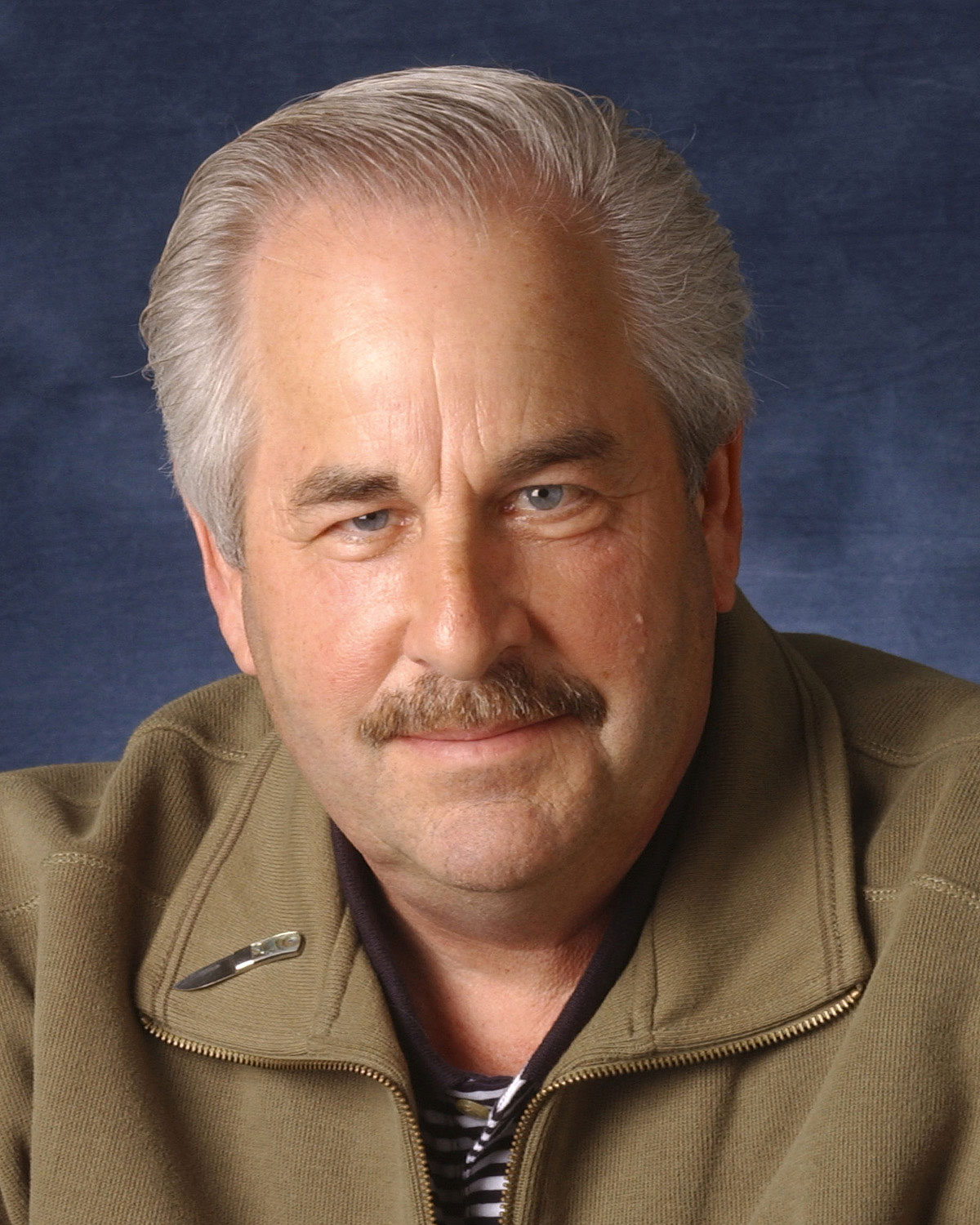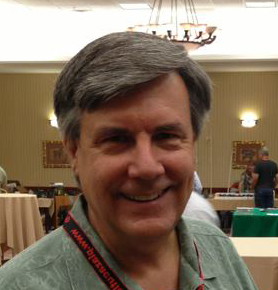BLADE Magazine Cutlery Hall of Fame®
The BLADE Magazine Cutlery Hall of Fame® is the highest honor on the planet for individuals who demonstrate exceptional contributions to the world of knives. Only one or two people are inducted annually during a ceremony at BLADE Show.
Inductees are determined by the Hall’s sitting members. An inductee must meet five criteria.
- Demonstrated extraordinary service to the knife industry.
- Displayed honesty, character and integrity.
- Advanced the industry by the creativity and originality of his or her works or contributions.
- As an ambassador or outstanding contributor has furthered the positive impact of the knife industry on the world at large.
- In summary, has demonstrated a worthiness to be a member of this prestigious group.
BLADE Magazine Cutlery Hall of Fame Inductees
Bo Randall (1983)
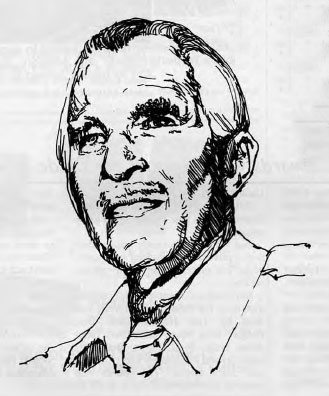 Few modern knifemakers got started without first being inspired by something they read or heard about Bo Randall.
Few modern knifemakers got started without first being inspired by something they read or heard about Bo Randall.
He pioneered handmade knives at a time when no one else was even considering it. Instead of trying to keep that market to himself, he promoted the business for everyone concerned, establishing a museum for visitors in his shop and offering encouragement to budding knifemakers.
He made knives when selling handmade knives required spending a lot of time and expense informing the customer, not about the specific knives, but why he might consider a handmade knife a better buy. That educated buyer later provided a ready market for the knifemakers that followed.
Getting the word out about handmade knives was not cheap, nor easy. It took a lot of work, time and expense. It took a special man to do it. Bo Randall was that man.
Dewey Ferguson (1983)
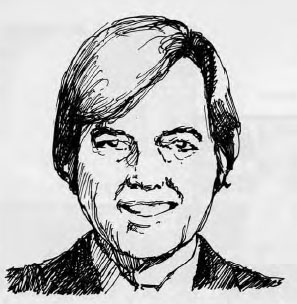 This Fairborn, Ohio resident devoted much of his life to writing knife collector books. He pioneered knife price guides with his “Romance of Knife Collecting” and “Price Guide to Romance of Knife Collecting” books. We feel that his books did more to promote knife collecting in the early days than just about any other single thing.
This Fairborn, Ohio resident devoted much of his life to writing knife collector books. He pioneered knife price guides with his “Romance of Knife Collecting” and “Price Guide to Romance of Knife Collecting” books. We feel that his books did more to promote knife collecting in the early days than just about any other single thing.
His book on Case knives, Romance of Collecting Case Knives was the best selling book the entire time it was published. He was offered the founding president’s position of the National Knife Collectors & Dealers Association, but turned it down in order to continue writing knife books. Sacrifice and devotion to a fledging industry was an everyday thing to Dewey.
It is safe to say that without Dewey Ferguson there very well may have not been knife collecting as we know it today.
Uncle Henry Baer (1983)
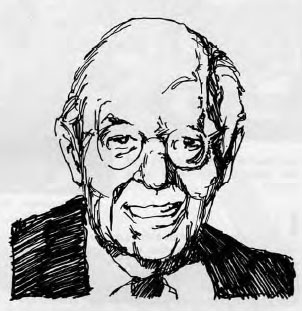 Being a successful cutlery factory owner does not qualify one to be inducted into the Cutlery Hall of Fame. It takes more. Uncle Henry has done much more.
Being a successful cutlery factory owner does not qualify one to be inducted into the Cutlery Hall of Fame. It takes more. Uncle Henry has done much more.
Through Schrade Cutlery under his direction and through his own personal efforts he has promoted the cutlery industry as perhaps no one else could. His is always the first letter congratulating anyone on a new cutlery endeavor, and his support of the cutlery publications and organizations has been unequaled among American cutlery company Presidents.
He helped to pioneer the commemorative market, and his company has made a great many of the commemoratives. His promotion efforts through the Schrade Almanac, magazine offers inside Schrade knives, and many other related promotions have enabled thousands of people to enjoy the hobby of knife collecting they might not have without Uncle Henry’s efforts.
When you hear of a nice elderly gentleman who pats little children on the head and gives them their own pocketknife, you have described Uncle Henry Baer.
Al Buck (1984)
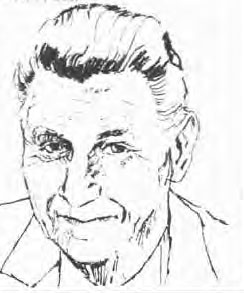 Who would want a knife with a lockback? That question never deterred Al Buck from building Buck knives into a cutlery legend, taking a small handmade operation and building it into one of the most recognized names in cutlery today.
Who would want a knife with a lockback? That question never deterred Al Buck from building Buck knives into a cutlery legend, taking a small handmade operation and building it into one of the most recognized names in cutlery today.
Buck didn’t invent the lockback, but he certainly popularized it, and despite a flood of other lockbacks the Buck knife still leads the way. If you are carrying a lockback today you can thank Al Buck for his enduring promotional efforts. You have a safer knife for it.
Al Buck is a gentleman, a patriarch of one of the few family-owned cutlery concerns in the U. S., and a cutlery legend.
William Williamson (1984)
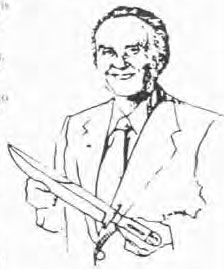 William R. Williamson is the ultimate authority on the subject of the Bowie knife. There’s not any financial reward in that title, just years of research and study.
William R. Williamson is the ultimate authority on the subject of the Bowie knife. There’s not any financial reward in that title, just years of research and study.
He is not content just to have that knowledge but he readily shares it, whether a column in Guns & Ammo, The Blade Magazine, or traveling halfway across the world to display his knives in the Sheffield museum or a Louisiana Parish A collector of several historical collectibles, his focus remains on knives, and that knowledge he shares continues sharing.
That’s why W. R. Williamson is in the Cutlery Hall of Fame.
M.H. Cole (1984)
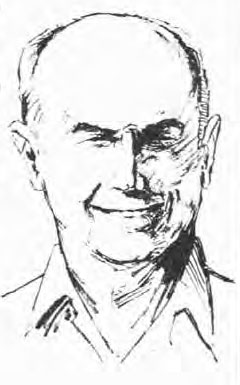 If it were not for M. H. Cole there would be little known about the American military knife. Few people will ever know as much about military knives as Cole, but many will know much because of the work he put into a long series of authoritative works on the American military knife.
If it were not for M. H. Cole there would be little known about the American military knife. Few people will ever know as much about military knives as Cole, but many will know much because of the work he put into a long series of authoritative works on the American military knife.
Few authors refer to a military knife without first citing the page on which that knife appears in the “Cole book.”
His enthusiasm pours over into hunting knives, Bowie knives, and dozens of other high grade collectibles. He has helped, and he continues to do so. We are better off with his having taken an interest in knives!
James Lile (1984)
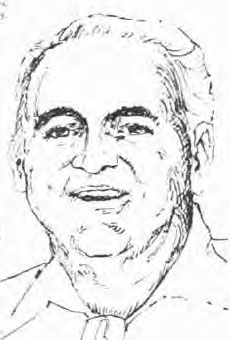 Mr. Jimmy Lile’s knives have made their way into the hands of presidents, senators, and movie stars. For years Lile was regarded as the official spokesman of the handmade knife industry.
Mr. Jimmy Lile’s knives have made their way into the hands of presidents, senators, and movie stars. For years Lile was regarded as the official spokesman of the handmade knife industry.
He has navigated the Knifemaker’s Guild through perilous times as its president, and unselfishly gave to the industry far beyond the normal point of giving.
His knives appear everywhere: from the movie, First Blood to the cover of the Russellville, Arkansas phone book. His work included helping Arkansas legislators repeal the century old state ban on Bowie knives!
He’s trod on the new ground and paved the way for many people. Luckily for the trade he continues to pave that ground.
Robert Loveless (1985)
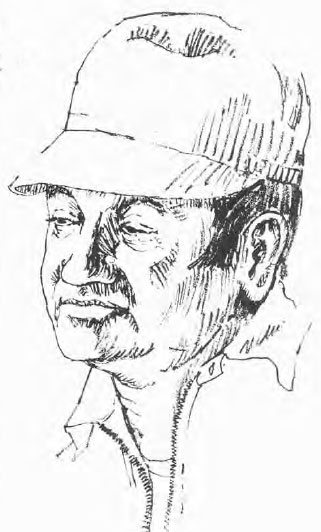 A hunting knife on the table of nearly any American knifemaker today will show the influence of knifemaker Bob Loveless. In the beginning he turned the knife industry on its ear, and made modern handmade knifemaking possible.
A hunting knife on the table of nearly any American knifemaker today will show the influence of knifemaker Bob Loveless. In the beginning he turned the knife industry on its ear, and made modern handmade knifemaking possible.
He was at the beginning of everything: The Knifemaker’s Guild, drop point hunters, high quality steels, custom designs, How to Make Knives books, the Japanese Knifemakers Guild, the rise of Japanese cutlery manufacturers, utilizing handmade designs for American manufacturers. You name it and Loveless has had a hand in it.
He bristles at the word legend, but however he wears the mantle it is undisputedly his. There are parts of this world where handmade knives are not known, but the name Loveless is!
Pete Gerber (1985)
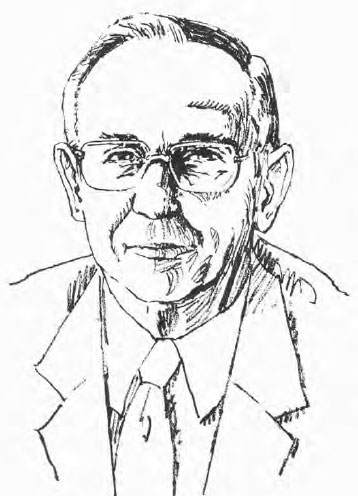 Starting out driving a delivery truck for his Dad’s business, Pete Gerber learned cutlery from the ground up. But becoming President of Gerber Legendary Blades is not a qualification for the Cutlery Hall of Fame.
Starting out driving a delivery truck for his Dad’s business, Pete Gerber learned cutlery from the ground up. But becoming President of Gerber Legendary Blades is not a qualification for the Cutlery Hall of Fame.
However, when the guiding force for that company surrounds himself with bright people and proceeds to lead the entire cutlery industry in innovations and modern designs, he deserves Hall of Fame recognition. Pete Gerber is that man. Many of his pioneering efforts have paved the way for other companies who found the going a little easier, because Pete paved the way.
An American manufacturer that also imports-new idea. Boot knives-new idea. Space age materials for knife handles and sheaths- new idea . The list goes on, but were it not for Pete Gerber that list would be much shorter than it is today.
William Moran, Jr. (1986)
 Bill Moran and knives. Knives and Bill Moran. The two are inseparable, like the forge and Damascus steel or a Moran knife and a razor-sharp cutting edge.
Bill Moran and knives. Knives and Bill Moran. The two are inseparable, like the forge and Damascus steel or a Moran knife and a razor-sharp cutting edge.
Add another pair to that list: Moran and The Blade’s Cutlery Hall of Fame.
Moran’s long overdue selection to the Cutlery Hall of Fame was announced at the Blade Super Show and Cutlery Fair this past summer in Knoxville, TN. Not that he needed recognition from the hall-his reputation as the American dean of Damascus and as the standard bearer for the forging method of making blade steel is revered worldwide.
James Parker (1986)
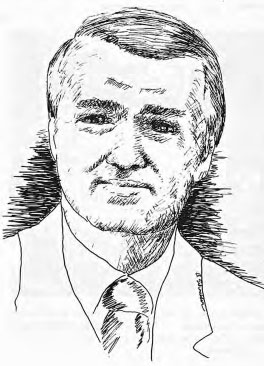 James F. Parker is a cutlery legend. Few men in recent cutlery history have had such an impact. His influence has touched every aspect of the knife market: collecting, mail-order, books, publications, show promotion, organizations, importing, manufacturing, fund-raising, and even a museum for the preservation of cutlery!
James F. Parker is a cutlery legend. Few men in recent cutlery history have had such an impact. His influence has touched every aspect of the knife market: collecting, mail-order, books, publications, show promotion, organizations, importing, manufacturing, fund-raising, and even a museum for the preservation of cutlery!
Thanks to the 1968 Gun Control Act, Parker switched from collecting guns to collecting knives. Within a few years he was the largest dealer of antique knives, primarily due to his innovation of a mail-order list of knives he had for sale. A price increase on his list would up the price for the entire industry.
Parker shoved that market along, as founding president of the National Knife Collectors Association, as one of the first producers of commemorative knives, as one of the first importers to supply the new market segment known as the “trader” market.
George Herron (1987)
 Hall of Fame members are special people. They’re givers. They have given of their knowledge, their time and their money that segments of knife interests might thrive and prosper.
Hall of Fame members are special people. They’re givers. They have given of their knowledge, their time and their money that segments of knife interests might thrive and prosper.
George Herron has given his all for over 20 years of knifemaking, as president of the Knifemakers Guild, founder of the South Carolina Association of Knifemakers and the teacher who walked along beside dozens of knifemakers, helping them take their first steps in knifemaking. He’s a hard fighter for the knife industry.
Dr. Frank Forsyth (1987)
 If you had been in Atlanta in 1974, you would have seen the knives of Dr. Frank Forsyth the first time they were ever displayed in public.
If you had been in Atlanta in 1974, you would have seen the knives of Dr. Frank Forsyth the first time they were ever displayed in public.
And you would have also seen them in Sacramento, CA, in 1977 … and in Hartford, CT, in 1978 … and at their last public knife show exhibition at the Blade Show in 1985. Along the way there was no cash remuneration for spreading a wall’s worth of knives for the enjoyment of knife collectors, just sometimes a trophy and the knowledge that for a few hours at every show a great many people enjoyed looking at his collection.
On behalf of those thousands of collectors who have stood in front of this man’s knives and were in turn inspired to build their own collections-or just enjoy knives a bit more, Dr. Frank Forsyth is welcomed into the Cutlery Hall of Fame.
Frank Buster (1987)
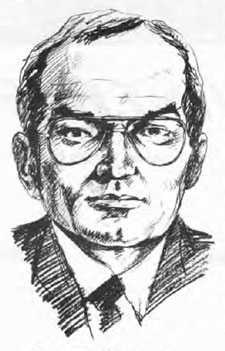 Frank Buster has pioneered the manufacture of regional club knives, and the quality knife he produced allowed many of those clubs to grow and prosper.
Frank Buster has pioneered the manufacture of regional club knives, and the quality knife he produced allowed many of those clubs to grow and prosper.
He was the first to give awards specifically to ladies for their collections, and by doing so added a whole new group of collectors to the industry. He understands collectors, because he is one. He understands giving because he is a giver-and that’s why Frank Buster is now in the Cutlery Hall of Fame.
A.G. Russell (1988)
 A creative mind led A. G. Russell into endeavors including knifemaking, mail-order cutlery sales and even whetstone manufacturing. Along the way he has attempted to save Bertram and Germany’s “Hen & Rooster” factory, was one of the very first to issue a commemorative knife (the Kentucky Rifle) and has helped dozens of knifemakers come into their own.
A creative mind led A. G. Russell into endeavors including knifemaking, mail-order cutlery sales and even whetstone manufacturing. Along the way he has attempted to save Bertram and Germany’s “Hen & Rooster” factory, was one of the very first to issue a commemorative knife (the Kentucky Rifle) and has helped dozens of knifemakers come into their own.
But there is one thing for which he most deserves praise, and that was in 1972 when he brought together a dozen or so knifemakers at a gun show and formed the Knifemakers Guild. There are those who say no one in 1972 foresaw what knifemaking would become – but A.G. Russell did see what was to come, and his efforts are what helped it arrive.
Ken Warner (1988)
In the late 1960s Ken Warner introduced the readers of the American Rifleman, the publication he was editing at the time, to the approaching popularity of handmade knives. There were knifemakers around, but it took someone like Warner to get the attention of sportsmen.
He stayed in touch with knives and, upon becoming editor of Gun Digest in 1980, immediately began a book series on knives that has influenced and aided the entire cutlery industry, the Knives ’81-’89 series.
His writing has made the world of knives something exciting for many, something people wanted to be a part of, and the industry has benefitted from his being a part of it.
Jim Bowie (1989)
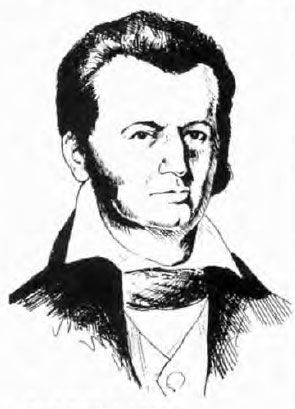 Jim Bowie is not only the most romantic figure in knife history, he is also one of the most romantic figures in American folklore. As the inventor of the Bowie knife, Bowie has inspired more people-ether directly or indirectly- to both own and/or make knives than anybody.
Jim Bowie is not only the most romantic figure in knife history, he is also one of the most romantic figures in American folklore. As the inventor of the Bowie knife, Bowie has inspired more people-ether directly or indirectly- to both own and/or make knives than anybody.
As for the original Bowie knife itself, whether it ever really existed or who designed it is a question that is best left to scholars. The same applies to Bowie ‘s exploits. But one thing remains certain: Jim Bowie deserves the lion’s share of credit for securing the Bowie knife’s place as an art form and as an unwavering piece of Americana.
Maury Shavin (1989)
 When you go to a knife show today, give a lot of credit for that show to Maury Shavin.
When you go to a knife show today, give a lot of credit for that show to Maury Shavin.
A charter member of the National Knife Collectors Association, Shavin has attended and supported practically every KCA s how from day one. Moreover, as one of the first wholesalers of cutlery.
Shavin helped establish many knife collectors and was one of the first to supply “wagon jobbers,” dealers who traveled rural back roads selling knives from the back of station wagons. He also was one of the first knife importers and was responsible for the domestic reintroduction of Kissing Crane Knives.
With his Knifepacs, Maury revolutionized storing, transporting and protecting knives. Until Shavin’s Knifepacs, many collectors carried their knives in aluminum siding sales cases, old salesman’s knife rolls or even homemade cases.
Hubert Lawell (1989)
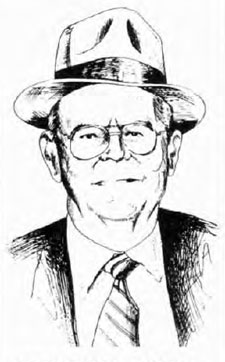 If you’ve seen Hubert Lawell ‘s unmatched collection of pearl-handle whittlers, then you shouldn’t be surprised that he’s been named to the Cutlery Hall-of-Fame. However, it’s not just the size of Hubert’s collection but what he’s done with it that accounts for his induction.
If you’ve seen Hubert Lawell ‘s unmatched collection of pearl-handle whittlers, then you shouldn’t be surprised that he’s been named to the Cutlery Hall-of-Fame. However, it’s not just the size of Hubert’s collection but what he’s done with it that accounts for his induction.
Lawell’s devotion to knife collecting is legend. He has carried his elaborate array of over 500 whittlers to knife shows around the globe, where is usually the star attraction. But what sets this fine, old country gentlemen apart is that he built his current collection after having a knife display of similar proportions stolen in the late 1970s. Rather than be discouraged and forsake knife collecting entirely, Hubert simply built another gargantuan display and resumed his role of knife ambassador at large.
William Scagel (1989)
 The next time you admire a handmade knife, remember that you probably would not be doing so if not for William Scagel.
The next time you admire a handmade knife, remember that you probably would not be doing so if not for William Scagel.
Scagel is the father of handmade knives as an art form and as a collectible. He was one of the first to make people appreciate a handmade knife not only as a tool but as a work of art as well. The word “handmade” was not a selling point of handmade knives until Scagel came along.
Perhaps the most enduring testimony to the greatness of Scagel is that he was the mentor to W.D. “Bo” Randall, who in turn is the father of everything else in handmade knives.
Gil Hibben (1990)
 There’s more to Gil Hibben’s induction into the Cutlery Hall of Fame than his reputation as a knifemaking individualist. Perhaps nowhere in the business is there one maker who has touched the careers of so many of his contemporaries.
There’s more to Gil Hibben’s induction into the Cutlery Hall of Fame than his reputation as a knifemaking individualist. Perhaps nowhere in the business is there one maker who has touched the careers of so many of his contemporaries.
Beginning in 1965 in his little knifemaking shop in Manti, Utah, Hibben started what writer Joe Ashman called “The Utah School of Knifemaking,” whose alumni include such craftsmen as Buster Warenski, S.R. (Steve) John son and the late Harvey Draper. In the years since, Hibben has always been accessible to any maker for advice or encouragement, either of which he ladles out in generous helpings.
His edged creations have names like “The Beast,” “The Bat,” “2001,” “The Black Widow,” and his most recent (as of the time of this writing in 1990), “The Alien.” His credits include the Rambo III knife for Sylvester Stallone and pieces made for such legends as John Wayne, Steve McQueen and Moshe Dayan.
Today, Hibben remains available not only to makers but to any enthusiast who wants to talk knives. Hibben combines a celebrity status with a personable nature. The next time you go to a knife show where he is a participant, approach him, shake his hand and congratulate him on his induction. Only then may you fully comprehend why this man is so deserving of the honor.
Harry McEvoy (1991)
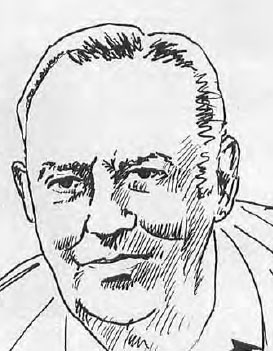 While knife throwing may prove to be his most lasting contribution to the knife industry, it’s but one of the reasons for Harry McEvoy into the Cutlery Hall-of-Fame. An accomplished researcher and writer, his books are among the final words on knife- and hawk-throwing, including, Knife And Tomahawk Throwing, Knife Throwing: A Practical Guide, and Knife & Tomahawk Throwing: The Art Of The Experts.
While knife throwing may prove to be his most lasting contribution to the knife industry, it’s but one of the reasons for Harry McEvoy into the Cutlery Hall-of-Fame. An accomplished researcher and writer, his books are among the final words on knife- and hawk-throwing, including, Knife And Tomahawk Throwing, Knife Throwing: A Practical Guide, and Knife & Tomahawk Throwing: The Art Of The Experts.
McEvoy has also written many how-to and historical articles on knife and hawk throwing for various periodicals, including several for BLADE.
In 1949, Harry founded Tru-Balance Knife Co. in Grand Rapids and has sold throwing knives to professionals and sportsmen for over 40 years. He has coached and demonstrated knife throwing for over 30 years and turned professional as a knife thrower in 1976, though he said he considers himself a better teacher than practitioner of the art. He is also a member and Fellow of the Company of Military Historians and is a Civil War enthusiast.
Buster Warenski (1992)
 Fellow BLADE Magazine Cutlery Hall-of-Famer Gil Hibben knew there was something special about Buster Warenski when he first met him in the late 1960s.
Fellow BLADE Magazine Cutlery Hall-of-Famer Gil Hibben knew there was something special about Buster Warenski when he first met him in the late 1960s.
“He’d taken this Buck folder apart, reduced it to about three-quarter size and put it back together,” Hibben said. “I told him, ‘Boy, if you can do this, you can make knives.”‘
And make knives Warenski has, from customizing that Buck folder art pieces he churns out today. It is the King Tut dagger, though, that probably best reflects why Warenski is in BLADE Magazine’s Cutlery Hall-of-Fame.
On top of the Tut dagger, Warenski’s career is studded with high points: election as president of the Knifemakers Guild in the late ’70s; his many art daggers and an occasional highly embellished folder to showcase his knifemaking versatility; and the Gem of the Orient, the $1.5 million dagger that graced the cover of the August 1991 BLADE are a few. Factor in wife Julie’s ample engraving talents to the current generation of Warenski knives and there seems no end in sight to the legacy of this remarkable maker, a truly deserving addition to BLADE Magazine’s Cutlery Hall-of-Fame.
Albert M. Baer (1992)
 Albert M. Baer is America’s leading legend in the cutlery business. His legacy is one of America’s great success stories, starting as a cutlery salesman and building what is now known as Imperial/Schrade, making up what some cutlery people estimate is control of over 113 of the nation’s domestic cutlery production.
Albert M. Baer is America’s leading legend in the cutlery business. His legacy is one of America’s great success stories, starting as a cutlery salesman and building what is now known as Imperial/Schrade, making up what some cutlery people estimate is control of over 113 of the nation’s domestic cutlery production.
“We have a saying at Imperial/Schrade that the genius of Mr. Albert M. Baer is his impatience,” former Imperial/Schrade CEO Wally Gardiner told BLADE.
Baer’s career began at Camillus where his first job was rubbing the cracks in bone handles with a crayon so that the knives could then be sold. From there he became one of the most successful salesman for Camillus, handling the Sears account, which at the time was the largest in the USA. He left there and arranged to buy a 35-man water-and-steam powered factory on the banks of the Beerkill River in Ulster County, New York, from the aging Dwight Devine family.
From this meager start he would establish a handshake deal with the folks at Imperial Knife to supply U.S. troops with knives during World War II, and expand to own Schrade Cutlery Co., and briefly hold I*X*L, Richards, and Rodgers in England,
Always the power in the background, always willing to let others be in the spotlight, Albert M. Baer was inducted into the BLADE Magazine Cutlery Hall-of-Fame for the simple reason that there may be no one in the past half-century of the cutlery industry who has had more of an impact on the knives we carry today than Albert M. Baer.
Col. Rex Applegate (1993)
 At 6’3″ and 230 Ibs., it was a physically imposing Rex Applegate who stepped into the Office of the Coordinator of Information (COI) in 1942. (COI later became the OSS, which later became the CIA.) There he met Maj. Gen. “Wild Bill” Donovan, who was so impressed with the then young Army captain that he gave Applegate the job of organizing a school for spies, saboteurs and assassins. That training camp adjoined what was to become President Roosevelt’s “Shangri-La” and later President Eisenhower’s Camp David.
At 6’3″ and 230 Ibs., it was a physically imposing Rex Applegate who stepped into the Office of the Coordinator of Information (COI) in 1942. (COI later became the OSS, which later became the CIA.) There he met Maj. Gen. “Wild Bill” Donovan, who was so impressed with the then young Army captain that he gave Applegate the job of organizing a school for spies, saboteurs and assassins. That training camp adjoined what was to become President Roosevelt’s “Shangri-La” and later President Eisenhower’s Camp David.
FDR was also impressed with Applegate and was instrumental in assigning Rex to the presidential camp bodyguard. Applegate later guarded FDR and Winston Churchill together. Applegate’s trainers in hand-to-hand combat included Capt. E.A. Sykes and W.E. Fairbairn, developers of the famous Fairbairn-Sykes fighting knife. Fairbairn also wrote “Get Tough,” a knife-fighting how-to classic.
During World War II, Applegate attended British Commando School, several Special Training Centers in Scotland and the London Street Fighting School. While there, he participated in a Commando raid into Nazi-occupied France.
In August 1942, Applegate was picked to ramrod Section VIII (Combat), considered by some the top training and research center in the history of close combat. The next year he wrote his classic “Kill or Get Killed,” a best-selling military and police manual on close combat, now in its 28th printing.
After the war he presided over gun sales firms in Mexico City that imported such brand-names as Smith & Wesson, Remington, Marlin and Pachmayr. While there, he also retained strong U.S. intelligence contacts. He trained Mexico City’s police and the Mexican Army’s Military Police in riot control and was named a brigadier general in the Mexican Army.
In 1963 he returned stateside to serve as a consultant during a decade of riots that rocked the country. He also wrote many articles on law enforcement, guns and riot control.
In 1980, the Applegate-Fairbairn Fighting Knife first appeared and has been reproduced by many custom knifemakers. As of this writing (in 1993) the Applegate-Fairbairn is available from Blackjack Knives. In 1988, Applegate modified the World War I1 Smatchet by giving it a double edge, a carbon steel blade and a Micarta handle. It was first made by Buck Knives and later by A1 Mar Knives.
It is with great pride that the Blade Magazine Cutlery Hall-of-Fame inducts Col. Rex Applegate, a true American hero.
Billy Ray (B.R.) Hughes (1993)
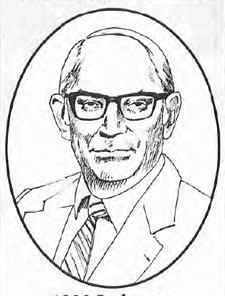 If Bill Hughes thinks you’re wrong about something, he won’t think twice about telling you. The next minute he’s slapping you on the back, laughing that explosive laugh of his, making you forget—or not care—about the disagreement you may have had with him moments before.
If Bill Hughes thinks you’re wrong about something, he won’t think twice about telling you. The next minute he’s slapping you on the back, laughing that explosive laugh of his, making you forget—or not care—about the disagreement you may have had with him moments before.
Maybe that’s what has made him such a successful PR man for the handmade knife movement. He’s a man of convictions who can tell it like it is without ruffling too many feathers-and he’s been telling it for nearly 30 years now.
Always fascinated by knives (he wrote a paper on James Bowie during his undergraduate days), Hughes began writing for daily newspapers in 1950-51. He took up the initials “B.R.” because there was another Bill Hughes writing for the Associated Press back then.
When he joined the staff of “Gunsport” magazine in 1965, the editor was fellow Cutlery Hall-of-Famer Ken Warner. After Warner left “Gunsport” in 1966, Hughes started writing about knives. Four knife books and over 300 magazine articles later he’s still writing about knives. His books include the “The Gun Digest Book of Knives,” co-authored with Jack Lewis in 1973, and “Modern Handmade Knives,” published in 1982.
But there’s more to Bill Hughes than writing-a whole lot more. Along with Bill Moran, Don Hastings and Bill Bagwell, he helped found the American Bladesmith Society in 1976. Then, in 1988, with Moran was instrumental in establishing the world’s only bladesmithing school, in conjunction with the ABS, Texarkana College and the Pioneer Washington Restoration Foundation.
Today Hughes is secretary of the ABS and has been dean of students at Texarkana College since 1968. He received the Don Hastings Award from the ABS in 1988 and the Outstanding Service Award from the Union College Student Personnel Association of Texas in 1985. But at heart he remains a writer, a writer who never has a problem with the turn of a phrase–or a quote-such as the one he uttered upon being inducted into the hall at the 1993 Blade Show Awards Banquet: “I probably don’t deserve this but you ain’t getting it back.”
J. Bruce Voyles (1993)
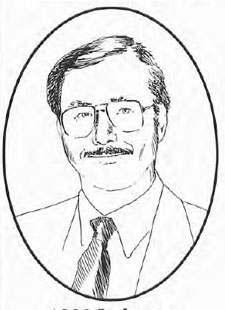 Before we get into what a nifty fellow Bruce Voyles is, it is important to note he is not a plain old Blade Magazine Cutlery Hall-of-Famer. He is the first Member’s Choice inductee.
Before we get into what a nifty fellow Bruce Voyles is, it is important to note he is not a plain old Blade Magazine Cutlery Hall-of-Famer. He is the first Member’s Choice inductee.
And there’s a reason for that. Over the years, the Cutlery Hall-of-Fame has achieved some distinction as a recognition of status. In general, knife people agree on at least 80 percent of the members; agree, that is, that those 80 percent would belong in any Cutlery Hall-of-Fame.
And this is the one we got. And we have it because Bruce Voyles invented it. It was and is his, except this particular cat got out of the bag, and so now the whole knife scene thinks it’s theirs.
Well, that left the inventive Voyles in a pickle. By most accounts, if it wasn’t his, he could have counted on being in the Cutlery Hall-of-Fame. He (with a lot of help, but this is about him) runs three publications (as of this writing in 1993), one of the three most important international knife shows, and has who-flung-the-chunk can’t put himself in the Cutlery Hall-of-Fame, now can he?
So, without reference to him and without his knowledge, the members of the Cutlery Hall-of-Fame installed him at his own Blade Show & International Cutlery Fair-by surprise. They did it because they wanted to and because they figured they could and because they figure he draws enough water to handle it.
Bernard Levine (1994)
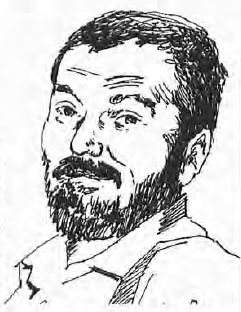 Bernard Levine is a cutlery expert, widely recognized as today’s leading authority on knife history and identification. Until his mid-20s he had only owned three cheap knives and no one, especially Bernard himself, would ever have imagined the future direction of his career.
Bernard Levine is a cutlery expert, widely recognized as today’s leading authority on knife history and identification. Until his mid-20s he had only owned three cheap knives and no one, especially Bernard himself, would ever have imagined the future direction of his career.
Bernard was born and raised in Boston. He went to Commonwealth School and Harvard, where he prepared for a civil service career in regional planning. Two summers working for the federal government and a senior thesis on the history of planning thoroughly disillusioned him with that field, so he dropped out in the middle of his senior year to begin his life anew. Still a scholar in the best sense of the word, he studied life by living it, working at a series of odd jobs in San Francisco-construction worker, longshoreman, janitor and more.
By happenstance, in 1971 Bernard bought a shoebox filled with 30 old knives for 10 cents each, and took them out to a flea market to sell. One was a Case, another a Henckels, the only two brands he knew.
Within two weeks he was in the old knife business full time. He kept a listing of every brand he encountered, the number quickly mounting into the hundreds. Soon he had dusted off his research skills and begun to track down what lay behind all those old names.
Prompted by Bill Cassidy and Bill Williamson, Bernard wrote his first knife articles (for “American Blade”) in 1974 and began work on his first book, Knifemakers of Old San Francisco. In 1975, the first of his many consultation projects, he cataloged the Wiebusch cutlery collection at the Smithsonian.
Early in 1978, when he gave up selling knives, Bernard published Knifemakers and began to write his “Whut Izzit” column for Knife World. Writing the column every month since, he has answered thousands of reader questions about old and unusual knives. His feature articles and monthly columns now total over 400, appearing in “The Blade Magazine,” Knife World, National Knife Magazine, Tokyo Knife and additional periodicals. His other knife books include The Knife Guide: The Knife Collection of Albert Blevins; Pocketknives; and three editions of Levine’s Guide to Knives and Their Values.
Although he is intrigued by knives, Bernard does not consider himself a collector. Still, he is always looking for that rare find, especially in knife lore. He says that the knife which interests him most is the one that he has never seen before. Just as important as the knife itself is the history behind it. Bernard can weave disparate threads of obscure information into a fascinating story about a knife.
Still the scholar, he is adamant about separating fact from fiction. He always welcomes information from fellow collectors and historians and credits them with much of his knowledge.
Bernard Levine is indeed a cutlery expert, one whose efforts have contributed significantly to knife collecting and to the enjoyment of those who pursue the hobby, as well as those who will follow well into the future.
C. Houston Price (1994)
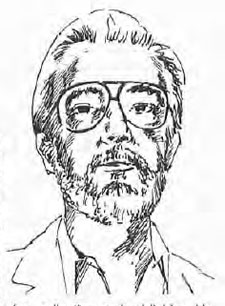 For more than 15 years Houston Price has been the editor/publisher of Knife World, but he can’t remember when he was not fascinated by knives. Since 1979 Houston has become one of the best-known figures in the world of knives.
For more than 15 years Houston Price has been the editor/publisher of Knife World, but he can’t remember when he was not fascinated by knives. Since 1979 Houston has become one of the best-known figures in the world of knives.
Through Knife World and as a collector he has helped raise the standards of knifemaking, manufacturing, collecting and publishing. He has traveled to knife shows around the country and to knife factories around the world, and he has shared the stories of his travels, as well as his love of knives, with his many thousands of readers and friends.
Houston and his wife, Betty, his partner in running Knife World, met when they were students at Berea College in Kentucky, and were married in 1955. While in college, Houston enlisted in the Marine Corps Reserve. After graduation, he received his commission. As a platoon commander he was sent to Beirut during the 1958 Lebanese crisis. He left the Corps in 1960 and began work in the agricultural industry. His work took him all across the United States and into South America.
Houston’s interest in knives grew all this time but it was still just a hobby, much like his accomplished guitar playing and ham radio.
In the mid-’60s, in Arkansas, Houston visited A.G. Russell to look at his Arkansas whetstones and custom knives. Houston joined Russell’s Knife Collectors Club and, through Russell’s referral, has subscribed to “The Blade Magazine” since the first issue. Houston attended his first knife show in 1973 in Atlanta. Later he joined the NKCA, served as a director on the NKCA board, and is now a life member. The seeds of his stock knife, plier knife, and custom knife collections were sown then.
In 1977 Houston’s brother, Doug, bought Knife World. He asked Houston to become a partner in the magazine but, with two daughters, Anita and Renee, in college, Houston did not want to change careers then. A year later, however, both daughters were married, and he and Betty, who had worked in schools and in real estate, were ready for a change. They moved to Knoxville and took over Knife World. Houston’s background in knives was informal and in publishing was non-existent, but he was not deterred. He learned the knife magazine business by doing it, and expanded into knife books (writing, publishing, wholesale, retail) the same way. In ’91 he wrote the Tenth Edition of The Official Price Guide to Collector Knives for Random House.
In 1987 Houston and Betty bought a farm 20 miles east of Knoxville and began construction of their dream home. Today the Knife World offices are on the upper floor of a new barn-like building a stone’s throw from the farm house. With Kim Knott, who has been with them since 1981, and a group of writers, they are the whole Knife World team. Downstairs are the kennels for the Prices’ dogs, a breed called Bouviers des Flandres. Breeding, training and showing these big black dogs has garnered Houston and Betty an international reputation.
Bill Adams (1995)
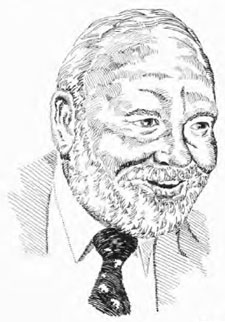 Bill Adams is known to most knife people as the president of Atlanta Cutlery and Museum Replicas. That’s his job, just as his job was once a physics professors, just as his job was once selling “rusty stuff” on the gun show circuit.
Bill Adams is known to most knife people as the president of Atlanta Cutlery and Museum Replicas. That’s his job, just as his job was once a physics professors, just as his job was once selling “rusty stuff” on the gun show circuit.
Bill realized that if guns had been made in England there were likely plenty of leftover rusty gun parts still there, so he flew to England and discovered there were a few gun parts, but that there were a lot more knife parts, and at that time in history the cutlery companies of Sheffield were closing right and left, just begging for someone to take their leftover stock, the knife parts, and anything else laying around. Bill was that person.
In some circles, it is said he looted Sheffield, buying among other things the I*XL exhibition knife collections. In reality, he saved much of it from the scrap-iron furnaces of Sheffield, and along the way he rescued the I*XL factory records, which would eventually end up where they are today in the Sheffield library.
He can tell you of sitting in the pubs talking to the old cutlers who lamented the failure of Sheffielders to preserve some of the older knives and records, when only a few hours earlier he had been loading those knives and records into the back of a rented Bently.
He started giving back to the cutlery industry from those early days. Those factory records, while in his protection, were open to any aspiring knife writer willing to brave the Sheffield coal dust still adorning their pages.
Along the way Bill has followed his motto, “If you want to lead the charge, you have to get in front and blow the bugle.” He has served as president of the Antique Bowie Knife Association (ABKA), helped found the Military Equipment and Weapons Collectors Association, and helped found and has chaired the Cutlery Collectors Legislative Committee since its inception. In the latter position he has beat on doors in Washington to fight anti-knife legislation, and has won his share of those fights.
His stature as president of the ABKA allowed him to put together “The Antique Bowie Knife Book,” a standard reference for serious bowie enthusiasts. Few other people in knives would have been entrusted with someone of the valuable bowies shown within those pages.
And while doing all this, Bill has pursued a Hemingway-esque lifestyle, from sailfishing in Costa Rica to hunting elephants in Africa, always with a smile and word of encouragement for everyone around him.
A man who gives back, who helps, who lives life large, and by so doing helps others around him live their lives large as well. Those are just a few of the reasons Bill Adam was inducted into the Cutlery Hall of Fame.
Jim Weyer (1995)
 Jim Weyer’s first encounter with handmade knives came while recuperating from a bout with multiple sclerosis. A friend came to visit bringing a handmade. He asked if Jim could photograph the piece. Jim visually devoured it like a connoisseur devours a Rembrandt or a Picasso. The knife was magnificent to Jim’s eyes. It was unbelievable to him that his friend could fashion such a work of art. Jim admired the curves of the blade, the fit of the handle and the grind lines. The knife was a simple hunter but to Jim it was “sculpture in steel.” Jim uses this term when he describes knifemaking to people who are not familiar with handmades.
Jim Weyer’s first encounter with handmade knives came while recuperating from a bout with multiple sclerosis. A friend came to visit bringing a handmade. He asked if Jim could photograph the piece. Jim visually devoured it like a connoisseur devours a Rembrandt or a Picasso. The knife was magnificent to Jim’s eyes. It was unbelievable to him that his friend could fashion such a work of art. Jim admired the curves of the blade, the fit of the handle and the grind lines. The knife was a simple hunter but to Jim it was “sculpture in steel.” Jim uses this term when he describes knifemaking to people who are not familiar with handmades.
When one looks at Jim’s work, both his commercial and knife photography, there’s a sense of something unusual about him. It is his vision. This vision has brought Jim much recognition. Early in his career, he was awarded Portrait of the Year of the World for his “Face of Family” featuring the first-born males (son, father, grandfather and great-grandfather) from one family. The photograph was used by Royal Trust Bank of Canada as a corporate identity. He was selected one of Toledo’s top 10 men for his contribution to the promotion of the city through his photography.
He photographed the infamous twin tornadoes that heaped devastation on toledo and outlying areas. The photograph provided documentation for scientists to prove the theory about the energy contained in a tornado but which had never been seen because tornadoes most often occur in the daylight hours. The two tornadoes were photographed at night. Jim assisted the scientists in the research and the final report.
Of all the photo pros present, Jim was the only one to capture the dramatic reunion between Bill Neihaus and his wife. Neihaus was the Illinois executive who was kidnapped in Venezuela and held captive for three years by Venezuelan rebels. The photograph was published in major magazines worldwide. Jim also serves on the Toledo Rotary Club board of directors, one of the world’s largest Rotary clubs.
Jim’s vision in photographing knives is well recognized. He is author and publisher of the four volumes of the “Knives: Points of Interest” series, a compendium of some of the world’s finest handmades. Handmades enjoyed a resurgence of new collectors as a result of these books, books which are on file in the U.S. Library of Congress.
Through his vision, Jim has improved the quality of photographs used by all the knife media. And, because of his vision, many potential collectors seek him out to learn about collecting handmades.
In addition to his vision, Jim’s goal is to further the growth of knifemaking and knife collecting. The goal is met with every new knife publication, every new issue of knife magazines, every new edition of the “Knives” annuals, and with every release of a new volume of “Knives: Points of Interest.”
The knife community has shown its appreciation for Jim’s contribution to knifemaking, both with private accolades and public recognition. He was awarded the first Doctorate of Knifemaking Photography given by Texarkana University through the American Bladesmith Society. Most recently he was inducted into the Cutlery Hall of Fame.
As he says, “The war is not over in the development of the knifemaking and collecting arena. There is still much work to be done and, frankly, the battle to get knifemaking and knife collecting accepted by the public as an art will be long and hard. I will be doing all I can to help win this battle.”
Chuck Buck (1996)
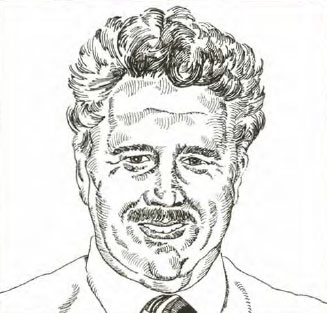 Chuck Buck heads a knifemaking company that proudly carries his family name, a company that today bears scant resemblance to its humble beginnings in Kansas at the turn of the century—at least at first glance.
Chuck Buck heads a knifemaking company that proudly carries his family name, a company that today bears scant resemblance to its humble beginnings in Kansas at the turn of the century—at least at first glance.
The third generation of the Buck knifemaking family, Chuck is quick to point out that despite all the changes, there’s still a dedication to the same basic concepts that guided his grandfather, Hoyt Buck.
The Buck Knife Co.’s ultimate aim always is to make better products. Chuck will tell you that while he’s proud of Buck knives, they’re not as good as they will be.
Through the years. the Bucks always have had an abiding faith in God. Chuck and his father, the late A1 Buck—-who also happens to be a BLADE Magazine Cutlery Hall Of Famer—have described with great conviction how they decided to make God the senior partner in their business.
Chuck has been a part of the family business since childhood. As a boy, he did odd jobs for his grandfather. As a teenager, he operated the family lawnmower shop that helped keep the knife company in business.
Among his tasks along the way was the preliminary preparation of worn-out files to be converted into the high-quality blades that always have been the hallmark of Buck knives. Chuck smiles when he explains that most people probably don’t realize that, until 1961, all Buck blades were made from discarded files.
His knifemaking career was interrupted by a tour of duty in the U.S. Navy. When he returned, he plunged back into the knife business just as the company incorporated and began to emerge as a major player in America’s knifemaking industry.
By 1970, Chuck was corporate vice president for manufacturing, involved in all aspects of the process, from purchasing to personnel to packaging.
Typical of his sense of humor and faith, he loves to tell the story about a “misjudgment” he made that wound up with a bright side. Here’s how he tells it:
“In the ‘60s,” he began, “a firm making our pocketknives expressed concern that our requirements were too stringent. They were producing knives that never got shipped because they wouldn’t meet our specifications. They hoped we’d relax our requirements. We didn’t.
“Instead, I offered them $1 for every knife that hadn’t qualified,” he continued. “I thought, ‘After all, how many could he have?’ I figured maybe a couple of thousand, tops. I couldn’t believe it when a truck backed up to our plant one day with 60,000 knives. Well, we donated all 60,000 to Christian missionaries, so it turned out that the decision to buy them back was not really a mistake after all because we played a part in helping missionaries all over the world as they shared Christ.”
Under Chuck’s leadership, the company took a bold and decisive step forward in 1980, completing a modern new plant and corporate headquarters with 4.5 acres under one roof.
Since then, the company has pioneered many new products, including the award-winning CrossLock series, and most recently (in 1996) the BuckTool, named The Blade Magazine 1996 Overall Knife of the Year.
Chuck, company president since 1979, proudly explains that the Buck family tradition continues, as his son, CJ, moves into increasingly pivotal roles as the company’s executive vice president.
Blackie Collins (1996)
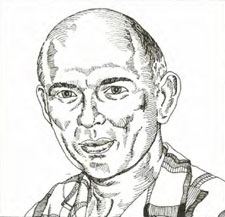 Knife industry ground breaker; knife-and-sheath designer; author; magazine editor and publisher; custom knifemaker: all apply to Blackie Collins. However, none capture the essence of the soft-spoken Southerner who could pass for a college professor and who’d probably rather be tooling down the highway on his Harley. No matter. He’s in The Blade Magazine Cutlery Hall Of Fame, taking his rightful place among the elite who have made the knife industry the constantly evolving entity that it is today.
Knife industry ground breaker; knife-and-sheath designer; author; magazine editor and publisher; custom knifemaker: all apply to Blackie Collins. However, none capture the essence of the soft-spoken Southerner who could pass for a college professor and who’d probably rather be tooling down the highway on his Harley. No matter. He’s in The Blade Magazine Cutlery Hall Of Fame, taking his rightful place among the elite who have made the knife industry the constantly evolving entity that it is today.
Perhaps cross-pollinator best describes Collins. He helped found The Knifemakers’ Guild, the world’s oldest organization of custom makers, in 1969, the same year he was granted his first cutlery patent. According to Blackie, he has over 60 patents on knife mechanisms, as well as many design patents.
In 1970, he crossed over to the factory side to produce the first authorized reproductions of Remington folders for Remington Arms Co. In 1972. he designed the first line of Smith & Wesson knives.
He changed hats again in 1973 to found the first-ever knife magazine, The Blade Magazine, known then as The American Blade. He did everything but sweep out the place-and he probably did that on more than one occasion. After printing the first five issues, he sold the magazine and went on to other things. Today, Blade is the world’s oldest and largest knife magazine, and is the only monthly national newsstand knife publication.
Also in the ’70s. Collins wrote books on how to make custom knives, the state of the commercial pocketknife industry, how to throw knives, and how to scrimshaw and carve ivory. It was the custom knives book that helped propel Collins into a job designing knives for Pete Gerber (another Cutlery Hall Of Famer) of Gerber Legendary Blades.
“Pete didn’t think the book would ever be printed,” Blackie said. “I sent him the first copy and he told me he wanted me to come work for him.”
In the late ’70s, Collins designed the first folder with a glass-filled nylon handle for Gerber. His first two Zytel-handle folders were the Gerber Bolt-Action Folder@ and Checkered LSTO, the latter being Blackie’s best-selling and most widely copied knife design.
“It has sold almost 3 million units in its original, unaltered form and is still a big seller,” he noted. “The Bolt-Action is also still a big seller.”
Collins designed and patented a revolutionary diving knife in 1980.
“I completely changed the way diving knives were made,” he explained. U.S. Divers, Wenoka SeaStyle, SeaQuest, Akona and Cetacea are diving equipment companies that make or market Blackie’s designs.
Some of Collins’ most important work has been the design and manufacture of sheaths. He sold his sheath company to Gerber in 1985. It currently produces over 150,000 sheaths per month in the original facility in North, South Carolina, with many of the sheaths being used by contemporary knife manufacturers.
Today, 20 companies are making knives based on Collins’ designs. Since selling his knife company, Benchmark Knives, Blackie said he as restricted his work to engineering and design for other companies and the production of diving knives.
“I occasionally make a handmade knife for a special customer,” he observed, “but most of my handmades are prototypes for production by other manufacturers.
“I’m happiest when I’m designing or making knives.”
Frank Centofante (1997)
 Frank Centofante’s induction into The Blade Magazine Cutlery Hall Of Fame@ at the 1997 Blade Show & International Cutlery Fair was one of the more popular additions to the august body in recent years.
Frank Centofante’s induction into The Blade Magazine Cutlery Hall Of Fame@ at the 1997 Blade Show & International Cutlery Fair was one of the more popular additions to the august body in recent years.
Taken completely by surprise by the announcement during the Blade Show Awards Banquet, Centofante sat half in shock, half overcome by emotion as his fellow Hall Of Famers gathered round to congratulate him. It was a fitting tribute to a man whose dry wit belies the dedication and leadership he showed in serving on The Knifemakers’ Guild board of directors for 18 years and as Guild president for nine years, the latter the longest presidential term in the organization’s history.
Voted in by his fellow Cutlery Hall-Of-Fame members-which is the only way to be inducted into the Hall-Centofante said the honor capped off his cutlery career, a career he said was highlighted by the landmark strides made by knifemakers and handmade knives in general through the Guild.
“It wasn’t me but the Guild board of directors that worked together as a team all those years,” the award-winning cutler said in typical humble fashion. “We did the best we could and set the standard for the Guild to follow for years to come.”
However, it was Centofante’s introductory speaker, friend and current Guild president, D’ Holder, a man who served on the Guild board of directors with Centofante all those years, who summed up Frank best with the following speech at the Blade Show Awards Banquet (reprinted here in its entirety):
“It’s a great honor to have the opportunity to introduce the next member to The Blade Magazine Cutlery Hall of Fame. We have not always agreed on the path, Old Friend, but always agreed on the destination. Many times I have wished for a small measure of your patience, understanding and infinite wisdom.
“He is a family man and father, married for 30 years to Sue. He also has three fine sons: Frank, Tampa fireman; Mark, an airline pilot; and Tony, a career student and future president of the United States.
“He once said that imitation is not the sincerest form of flattery, but too often is outright thievery; a knifemaker should develop his own style as soon as possible; keep the lines simple and appealing; emulate, but do not imitate; and walk a fine line between confidence and humility.
“He joined The Knifemakers’ Guild in 1971 and became a full-time knifemaker in 1977 after a long and successful career as a fireman and EMT.
“He served 18 years as a member of the board of directors of the Guild and nine of those as the organization’s president.
“He received the Guild’s Red Watson Memorial Friendship Award in 1984 and The Blade Magazine Publisher’s Award@ at this show one year ago. Other awards include the Knifeaholics Unanimous Knifemaker Extraordinaire Award and the Knifemakers Bocci Ball Championship in Italy in 1993.
“He is the only maker to have had a sheath stolen from him and the thief left the knife. I introduce to you the real Italian Stallion, Frank Centofante.”
Ron Lake (1998)
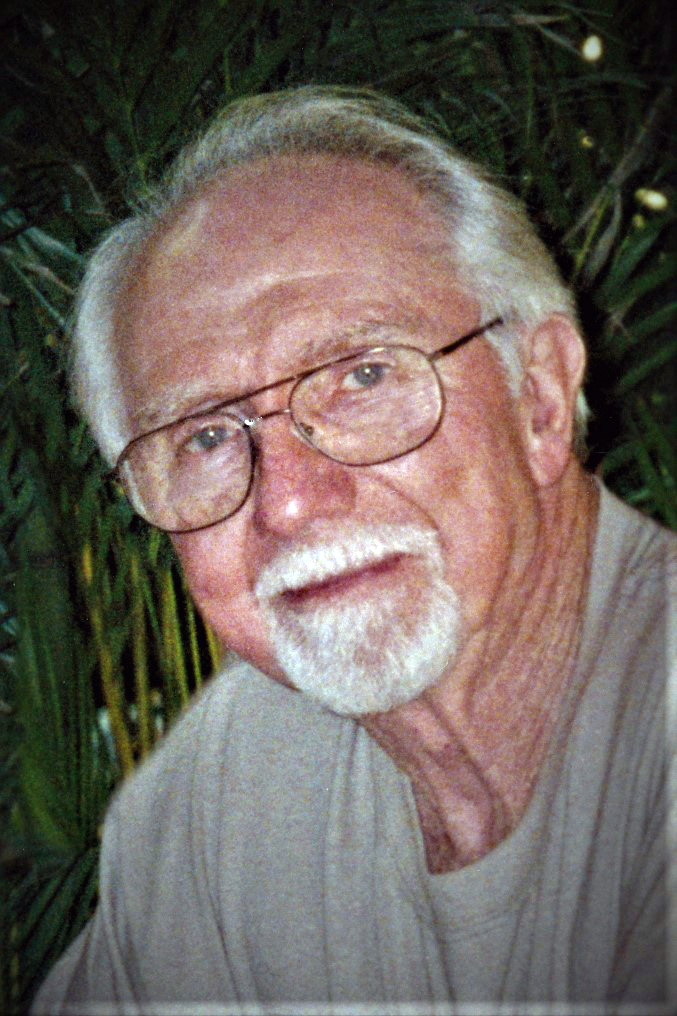 Any discussion of the modern handmade folder begins with Ron Lake, the latest inductee into the Blade Magazine Cutlery Hall Of Fame.
Any discussion of the modern handmade folder begins with Ron Lake, the latest inductee into the Blade Magazine Cutlery Hall Of Fame.
“I remember when he came to the Guild Show in Houston (1971) with the most beautifully finished folding knives I had ever seen,” recalled Blade Magazine Cutlery Hall-Of-Famer A.G. Russell in his speech inducting Lake at the 1998 BLADE Show Awards Banquet. “They were absolutely beautiful with what he called an interframe, which half of the handmade makers are now using, and a tail lock. Ron Lake has led the folding knife part of this industry for many, many years.”
Lake received a patent for the interframe in 1974. He also received a patent for his tail lock or “lever tab,” as he calls it, and the pivot bushing, the latter a little-known fact among knife observers.
“Many people were using pins instead of the bushing.” Lake noted. “Some factories still do.”
He first started making knives in Illinois in 1965.
“People think I was an overnight sensation but it took six years before I started making any progress,” Lake said. “Selling handmade knives to shotgun hunters in Illinois was not an easy go, not when they could buy a Buck knife for seven bucks and I was asking $25 for one of my handmades. Basically, I gave more knives away in five years than I sold. That’s something a lot of new makers should consider.”
Lake credits The Knifemakers’ Guild for much of his success.
“I’d like to thank A.G. Russell for having the foresight to form the Guild, because he gave me and others an opportunity to have more than our 15 minutes of fame.” Ron explained. “Bob Loveless recognized that I had accomplished something different with my folders, and his accolades when I first met him at the 1971 Guild Show set things in motion for me.”
Lake also credits writers B.R. Hughes and John Wooters for giving him the exposure in print that helped jump-start his career.
Lake’s honors include: the Guild’s Red Watson Award; two best knifemaker awards and one best folder award at the New York Custom Knife Show; two best folder awards at the California Custom Knife Show (which later became BLADE Show West); a best folder award at the Munich, Germany, Knife Expo; and a best folder award at the Paris Knife Show.
He served on the Guild board of directors for nine years, eight of those as vice president. Along with Frank Centofante and Wayne Clay, he authored the book, “How to Make Folding Knives.” In 1995, along with knifemaker Michael Walker, he formed Bullfrog Knife Co. Lake and Walker collaborated on the first-ever linerlock® safety mechanism, receiving a patent on it in 1997 and naming it the Interlock.
“I’m glad to have been elected to the Hall of Fame and to be recognized for my contributions to the business,” Lake said. “I think I’ve played a good part in helping the business come along from the beginning of the Guild to what it is now. I’ve tried to pass along what I’ve learned because what I’ve learned, I’ve learned by myself.
“The best award I’ve received is when people buy my knives,” he concluded. “If not for them, there wouldn’t be a knife business to enjoy.”
Sal Glesser (1999)
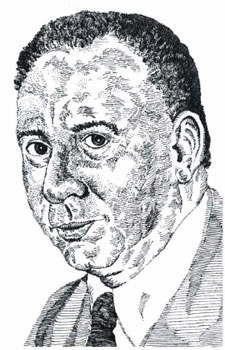 Sal Glesser, the genius behind the Spyderco knife with the hole-in-the-blade, the pocket clip and the serrations that changed the way an industry looks at folding knives, has achieved an edged immortality of sorts by being elected to The Blade Magazine Cutlery Hall Of Fame.
Sal Glesser, the genius behind the Spyderco knife with the hole-in-the-blade, the pocket clip and the serrations that changed the way an industry looks at folding knives, has achieved an edged immortality of sorts by being elected to The Blade Magazine Cutlery Hall Of Fame.
The leading vote getter in a vote by sitting members of the Cutlery Hall Of Fame, Glesser was inducted into the shrine this past June at the BLADE Show & International Cutlery Fair. The road to the Hall has been a long and winding one for the latest inductee.
Sal and his wife, Gail, launched Spyderco over 20 years ago in the back of a bread truck. Their first product was a serrated knife sharpener, and the Glessers made a living early on selling sharpeners and sharpening other people’s knives.
“We barely made the truck payment,” Sal recalls, “and we were living in the truck.”
Then, in 1981, he designed and produced the first Spyderco knife, the Worker, the initial piece with the familiar hole-in-the-blade for easy one-hand opening and a pocket clip. Next, in 1982, came the first serrated Spyderco knife, the Mariner. Despite the unique designs, the early- to mid-1980s were a struggle for Spyderco. But Sal plugged along, taking his sharpeners and knives to shows where people had a need for such things, demonstrating his sharpeners and his knives to whomever would watch.
It was at one such show that knifemaker Bob Terzuola set up at a table across from the Spyderco booth. In his speech introducing Glesser as the latest inductee into the Cutlery Hall Of Fame at the BLADE Show Awards Banquet, Terzuola recalled the experience as if it were yesterday.
“Sal was right across the aisle from me and, for three solid days, I was subjected to the Spyderco pitch—how to sharpen a knife on a ceramic sharpener,” Terzuola began. “Sal would grab some poor, unsuspecting character walking down the aisle and say, ‘Excuse me, sir. Do you have a knife in your pocket?’
“Sal would get out his jeweler’s loupe and look at the edge of the knife and say, ‘Boy, that’s not really very sharp’ and say, ‘Let me show you how this sharpener works,’ and he’d stand there and sharpen the knife.
“(Sal) had this pile of paper next to him and he’d pick up this slim piece of paper and he’d take that guy’s knife and slice it and cut it into neat little paper dolls and circles and triangles and all. The guy’s eyes would be wide and, in the meantime, other people would gather round. Sal sold a boatload of those sharpeners.
“By the end of the weekend on Sunday, I’m packing up and Sal’s packing up and he’s got this whole table full of knives, axes, even some rooster spurs used for cockfighting in Mexico,” Terzuola continued, “and he sharpened all these things and had them all on his table. I went over to him and introduced myself and said, ‘Sal, that really is a very impressive demonstration,’ and Sal said, ‘You know, the sharpener is really good. Otherwise I wouldn’t be selling it. But it doesn’t matter how sharp the knife is. I can (cut paper) with any knife on the table,’ and he proceeded to do it with kitchen knives and axes and chisels.
“And he said, ‘I can do it with the back of the knife,’ and turned the knife over and did it with the back of the knife. ‘I can even do it with another piece of paper,’ and he got a piece of paper and cut another piece of paper into little dolls and triangles. ‘You’ve got to keep your eye on the bouncing ball and know what you’re selling,’ Sal told me. ‘It’s when are you gonna cut paper, it’s not so much in the sharpening.”‘
Some time in the late 1980s, Spyderco knives began to capture the imagination of knife enthusiasts on a grand scale. Whether it was such landmark models as the Police, Endura and Delica; Spyderco’s introduction of what has become a long line of reproductions of handmade designs, the first of which was by Terzuola; its many Blade Magazine Knife-Of-The-Year Awards; its role in helping to pioneer hi-tech materials and designs; or a combination of factors, Spyderco’s knives took off and they are still barreling along out there in space.
Behind it all was Sal Glesser.
As Terzuola said, “His passion has always been for performance. He’s always told me, whether it’s in a car, or a knife, or in a person who is working for you, it’s performance that you’re looking for.
“But, more than that, Sal has always cared for the customer. And it’s a lesson that I learned over a long period of time that the customer, the person who buys (knives) and puts down his hard-earned money, expects in return integrity and expects a product that’s going to work and a company that’s going to back it up. And Sal has shown this in the way Spyderco works, in its success, in its performance, in its growth, and its innovations and its constant quality.”
Of course, it is not just Glesser’s knives but his complete vision of them—the responsible and proper use of them and their role in society—that makes him worthy of the Cutlery Hall Of Fame. His active support of the American Knife & Tool Institute, for which he was a winner of The Blade Magazine 1998 Publisher’s Award, is proof of that.
Welcome to the Cutlery Hall of Fame, Sal. You’ve earned it.
Joe Drouin (2000)
 In becoming the first-ever inductee into The Blade Magazine Cutlery Hall Of Fame based solely on the collecting of handmade knives and support of the custom knife movement in general, Joe Drouin adds a welcome dimension to the industry’s ultimate knife shrine.
In becoming the first-ever inductee into The Blade Magazine Cutlery Hall Of Fame based solely on the collecting of handmade knives and support of the custom knife movement in general, Joe Drouin adds a welcome dimension to the industry’s ultimate knife shrine.
The knife enthusiast’s knife enthusiast, who has displayed his handmade knife collection at major shows and served as the custom industry’s No. 1 P.R. man for over two decades, was inducted this past June at the BLADE Show. Few, if any, have promoted the handmade industry by educating the public at knife shows and through magazine articles the way the Bremerton, Washington, resident has, and he accepted his induction with typical humility.
“To be a member of the Cutlery Hall Of Fame with such honored company who have done so much more than I have just floors me,” the 67-year-old noted.
It has been a long yet satisfying journey for the U.S. Navy and Air Force veteran, who started out collecting factory knives and then became a custom knife collector in 1977 after seeing the Jack Holifield collection at a Las Vegas gun show. Buying his first handmade knife from Jim Pugh and his second from Buster Warenski, Joe built his collection and began taking it to knife shows in 1978, and has done so ever since.
Drouin selected Butch Winter, long-time knife writer and handmade knife collector, to introduce the latest inductee at the BLADE Show Awards Banquet, and Butch captured Joe’s contributions as only a fellow collector could.
“Joe used his display to share his love of custom knives with others, which without doubt stirred their interest and encouraged many of them to begin their own custom knife collections. Why is this important?” Winter asked rhetorically. “It’s important because the custom knife movement could not have prospered without collectors. If collecting production knives were to cease tomorrow, it would be a mere blip on those companies’ bottom line, but if collecting custom knives were to cease, how many custom knifemakers could stay in business?
“Custom knives may have come to be as a better knife for the hunter and outdoorsman, but those of us who hunt know that a dedicated hunter really needs only one good knife, two at most, and the vast majority of hunters are going to buy the least expensive knife they can. They’ll then spend the rest of their money on the other hunting equipment they need.
“If making knives for the outdoorsman had remained the only purpose of custom knifemakers,” Winter maintained, “then, in all probability, instead of the growing, viable movement we see today with new knifemakers appearing on the scene in ever-increasing numbers, there would be a scattered few making superlative hunting knives as it was in the days of William Scagel, Frank Richtig and Harry Morseth.
“It was, and is, the collectors who have brought custom knives to where they are today. In the past 30 years, those of us who have watched and experienced the custom knife phenomenon have seen collectors come and go. We’ve also seen collectors who have come and stayed. A few of these have unselfishly given of their time and treasure to display their collections to promote custom knives and the custom knife movement.
“No one fits this description better than Joe Drouin.” Winter observed. “Over the years he has demonstrated his loyalty to custom knives by traveling further, working harder and showing his collection to more knife lovers than anyone else. He will be the first custom knife collector inducted (exclusively because of collecting handmade knives) into the Cutlery Hall Of Fame. It couldn’t happen to a nicer guy.”
All good things must come to an end, of course, and so, too, has Drouin’s amazing streak of displaying his collection at major knife shows. Suffering from failing health, Joe is no longer able to lug 40-pound suitcases full of knives through airport checkins and set up his three or so display tables at shows-though he will continue to display on special occasions in the Northwest, USA.
However, The Knifemakers’ Guild will help sustain the Drouin legacy by exhibiting Joe’s In Memoriam Section of deceased Guild knifemakers’ knives at future Guild Shows, including the most recent show in New Orleans. Moreover, other of the knives in Drouin’s collection will be maintained at the ABS Museum in Little Rock, Arkansas, and the National Knife Museum in Chattanooga, Tennessee.
“I want my legacy to be my sharing my knives with the public,” Joe said. “I’ve enjoyed educating the public, be it on handmade or factory made knives. I’ve enjoyed freelancing informative articles in the knife magazines. I’ve enjoyed saying the same things over and over again to the public at shows.
“I’ve helped new collectors to display who were intimidated by displays such as mine. I say to them, it’s not how many knives you have, it’s what you have and how you present them.”
And how Drouin has presented handmade knives over the years, not for his own personal profit but as tools to educate and entertain those who would listen, has been a credit to the industry in ways that have benefited, are benefiting and will benefit it for years to come. Welcome to the hall, Joe—you’ve earned it!
Bob Schrimsher (2001)
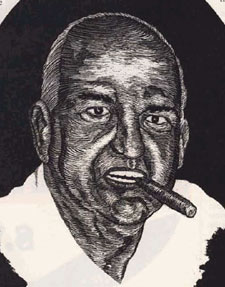 Handmade knives wouldn’t be as you know them today if it weren’t for Bob Schrimsher, the latest inductee into the Blade Magazine Cutlery Hall of Fame.
Handmade knives wouldn’t be as you know them today if it weren’t for Bob Schrimsher, the latest inductee into the Blade Magazine Cutlery Hall of Fame.
It was Schrimsher who, in 1969, began Bob Schrimsher’s Custom Knifemaker’s Supply in Emory, Texas, basically the only knifemaking supply business at the time.
“There was no Koval Supply, no Sheffield Supply, and Knife And Gun Finishing Supplies didn’t exist. Bob was it,” noted A.G. Russell, Cutlery Hall-of-Famer who helped induct Schrimsher at the 2001 BLADE Show Awards Banquet.
According to Russell, he gave all his sources for buying steel, brass, nickel silver and handle materials to Schrimsher in ’69, and from then through the 1980s Bob supplied knifemakers everywhere.
“He was a friend to everybody who made knives,” A.G. recalled. “He’s one of the nicest people in the industry, and that’s in an industry full of really nice people.”
According to a story on Schrimsher written in the early 1970s by Cutlery Hall-of-Famer B.R. Hughes, Bob’s first catalog—issued in ’69—featured “seven different blades, six styles of sheaths, seven types of wood, five different stag items, six sizes of brass stock and six sizes of stones.”
As Hughes wrote, two-thirds of the full-time knifemakers of the day got their materials from Schrimsher. Among them were Ted Dowell, D.E. Henry, Corbet Sigman, Lloyd Hale, Cutlery Hall of Famers Bob Loveless and Bo Randall, and many more, including Cutlery Hall-of-Famer Blackie Collins.
Due to failing health, Schrimsher was unable to attend the banquet to accept his award, so Collins accepted it for him. Russell said he’d offered to pay for Bob’s travel and accommodation expenses, but the long-time supplier simply was physically unable to attend.
Blackie has stayed in touch with Schrimsher over the years and recalled their initial meeting.
“When I first met Bob (circa 1970), I called him and told him about some of the supplies I needed,” Collins began. “He invited me to come to his place in Emory.”
When Blackie stepped inside Schrimsher’s supply warehouse, his jaw dropped.
“I thought I was in a knifemaker’s mecca because in the back of the warehouse were stacks and stacks of things that, to me, were like gold—Micarta, ivory, stag, every kind of steel, every kind of brass, everything [a knifemaker] could need,” Collins recalled.
Schrimsher also had all kinds of knifemaking equipment and introduced Blackie to the square-wheel grinder. Until that time, Collins noted, he had thought a square-wheel grinder was somebody’s idea of a bad joke.
“I bought my first square-wheel grinder from Bob,” he said, adding that he still uses some of the knifemaking equipment he purchased from Schrimsher.
Standing in Bob’s warehouse on that fateful day around 1970, looking at all those knifemaking supplies, it suddenly hit Blackie: How much was it going to cost him to get the materials he needed?
“Because one thing that all knifemakers had in common in the ‘60s and ‘70s,” Collins said, “was a lack of money. All of us were sorta [broke]—with a few notable exceptions. [But] Bob said just take what you need and I said, ‘I’d like to but I can’t afford what I need.’ He said, ‘Pay me when you get the money,’ and I was startled; he didn’t know me.
“But I came from find out that Bob was like that to just about anybody. He would let you go into his warehouse … and pick out what you needed, make a list of what you wanted, tell him what you were getting, pay him what you could and pay him when you could.
“I probably owed Bob a lot of money for a long time,” Collins noted, “as did … a lot of [knifemakers].”
There are still makers indebted to Schrimsher—not just monetarily but for all the times he fronted them materials, equipment and other favors.
As Russell noted, “Bob Schrimsher, for many years, carried knifemakers.”
For such a man, induction into the Cutlery Hall of Fame almost seems insufficient. Not only do some makers still owe him for an untold amount of knifemaking supplies, but the handmade industry in general owes him for a significant part of its very existence.
Rudy Ruana (2002)
“If there’s a Hall of Fame for knifemakers, Rudolph Ruana, Bill Scagel and Bo Randall should walk in, no competition, as the first three to be elected.”
-B.R. Hughes, 1976
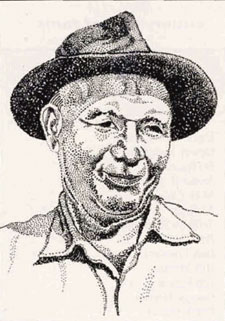 When B.R. Hughes wrote the preceding as associate editor of Gun Week, there was no such shrine for cutlers. Seven years later, the Blade Magazine Cutlery Hall of Fame was created and the first three inductees did indeed include Randall, but not Scagel and Rudolph H. “Rudy” Ruana. Of course, the Cutlery Hall of Fame is for the entire knife industry, not just knifemakers. Still, Hughes did get one out of three right.
When B.R. Hughes wrote the preceding as associate editor of Gun Week, there was no such shrine for cutlers. Seven years later, the Blade Magazine Cutlery Hall of Fame was created and the first three inductees did indeed include Randall, but not Scagel and Rudolph H. “Rudy” Ruana. Of course, the Cutlery Hall of Fame is for the entire knife industry, not just knifemakers. Still, Hughes did get one out of three right.
Of Finnish descent, Ruana was born on April 11, 1903. He made his first knife as a boy from a nail, using his dad’s forge to heat the steel. In the early 1920s, he served as a blacksmith and farrier in the Army. He made knives by emptying powder from .30-06 shells, pounding out small blades from the shells with a hammer and anvil. He sold the resulting knives for 50 cents each. Sometime during his hitch he forged a knife from a section of Ford automobile spring he found in a ditch by the side of the road. Automobile springs were a source of knife steel he would return to time and again.
In 1932, he married Helmi Hellman. In 1938, Ruana found work as a welder and mechanic in a Bonner garage and began making hunting knives on a regular though part-time basis. He continued making knives through the ‘40s and the early ‘50s, by which time the orders were starting to pile up. By 1953, he decided to make knives full time.
Ruana knives are unmistakable in style. His early ones were made of vanadium spring steel and silica manganese spring steel. In 1962, he started using 1095 high carbon steel. Here’s how he described his knives in his 1966 catalog:
“These knives are made by a combination of handcraft processes and the use of modern power tools. The blades are made of finest Hi-Carbon spring steel, forged with a modern power hammer, freehand hollow ground, individually oil quenched and heat treated. The handles are made of aluminum, cast directly on the tang, with native Montana elk horn inserts beveled and riveted.”
All told, Ruana offered almost 40 models over the years, including some large, impressive knives, and he also made some special-order knives. For the most part he made them inexpensive and to be used, like a god knife should. The knives were extremely poplar with hunters, so much so that Helmi remembers Oregon and Washington hunters bound for Montana knocking on the Ruanas’ door at 3 am. to buy blades.
As Martin Onishuk wrote:
“A hunter, a trapper, or a guide would show another how this sturdy knife, forged by the stocky Finn, could split the brisket of an elk, or, in a pinch, open a can of beans and still take a razor edge.”
In 1964, Ruana realized that none of his sons wantad to join him making knives. As a result, he announced plans to shut down the business and retire in four years at 65.
However, his son-in-law, Victor Hangas, Ilona’s husband, quit his job and went to work for Ruana, gradually taking on more and more of the knifemaking tasks. Rudy stayed on and didn’t retire until 1984 at the age of 81. Through it all, he frequently worked six days a week at his forge and grinders. He died on April 29, 1986.
Ruana knives are still made the old way in Bonner by Victor Hangas and are in demand nationwide. There are 17 models of bowies and about 25 hunting and skinning knives, and some hatchets. Prices range from $55 to $425, with a typical hunting knife selling for about $85, as of this writing in 2002.
D’Alton Holder (2003)
 After a 37-year career that has seen him make countless of his familiar fixed-blade hunters with stacked natural-material handles and serving The Knifemakers’ Guild about as long as anybody, D’Alton Holder has attained membership in the select club of the Blade Magazine Cutlery Hall Of Fame®.
After a 37-year career that has seen him make countless of his familiar fixed-blade hunters with stacked natural-material handles and serving The Knifemakers’ Guild about as long as anybody, D’Alton Holder has attained membership in the select club of the Blade Magazine Cutlery Hall Of Fame®.
Out polling the second-place finisher by a margin of two-to-one in a vote of sitting Hall-Of-Fame members, Holder figuratively knocked the door down after knocking on it for so many years.
The man known to many simply as “D” made his first knife in 1966, selling mostly at gun shows until 1973 when he joined the Guild. He was elected as a Guild board director in 1976 and served on the board for 23 years, during which time he held every board position, including three terms as president. His leadership helped sustain the Guild through the early years of its existence and he continues to impact the Guild to this day.
Holder organized the Arizona Knifemakers Association in 1975 and was its president for five years. He received the Guild’s Red Watson Award in 1982 and the American Firearms Industry Award of Merit in 1983, the only knifemaker to receive the honor. He was presented the Beretta Award for knifemaking excellence in 1994. He also served three years as president of the Arizona Knife Collectors Club.
He’s a charter member of the board of regents of the American Knife & Tool Institute. Holder also was one of the winners of the 1998 Blade Magazine Publisher’s Award® for his efforts on behalf of the AKTI.
He’s taught dozens of knifemakers how to fashion knives and helped dozens of other makers become more accomplished at the craft.
“He has led by example,” one Hall Of Famer noted, “and has exhibited excellent craftsmanship in his knives.”
In his speech inducting Holder at the 2003 BLADE Show awards banquet, ABS master smith Tim Hancock, a long-time friend of the inductee’s, may have said it best:
“His knives embody his philosophy of art and his dedication to great work and business ethics,” Hancock began. “He has no doubt made a friend of everyone he has sold a knife to.
“He also saw the need to shape the future of the industry that he loved. In his spare time he has advised, helped and counseled volumes of fellow knife enthusiasts, knife promoters and budding knifemakers in their pursuits in this industry. To put it simply, those of us who know him personally would say that his most amazing trait is his unselfish devotion to helping others.
“He has an exemplary work ethic that few other makers, if any, have matched,” Hancock continued. “The knives he makes are like an extension of his signature—they stand out in a crowd as his without seeing the name on them.
“The man who I’m talking about would say that he’s just a knifemaker. In fact, he jokes about the ratio of dirt and debris that’s made in the production of a knife. A common response [from him] when asked what [he’s] doing is ‘making dirt.’ He has no doubt made more than dirt and knives—he has made a real mark in the world.”
Michael Walker (2004)
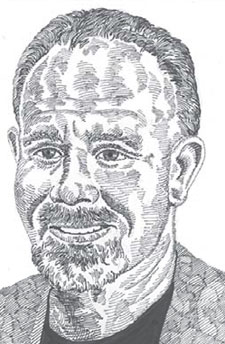 Michael Walker, “Lord of the Liner-Lock™” and author of some of the most imaginative hi-tech folders ever, was welcomed into the Blade Magazine Cutlery Hall Of Fame® June 5 at the 2004 BLADE Show.
Michael Walker, “Lord of the Liner-Lock™” and author of some of the most imaginative hi-tech folders ever, was welcomed into the Blade Magazine Cutlery Hall Of Fame® June 5 at the 2004 BLADE Show.
Inducted at the BLADE Show Awards Banquet in a heartfelt speech by fellow Cutlery Hall-Of-Famer Frank Centofante, Walker takes his place among his fellow cutlery luminaries on the heels of a knifemaking career that spans 30 years.
In 1975, he was making jewelry when Patricia Walker gave him a large Gerber folder and a copy of BLADE Magazine®, then known as American Blade. He was surprised to see people making knives not unlike the way he made jewelry. From that point forward he was hooked on making knives and, on Jan. 1, 1980, went full time.
“Fortunately for the knife industry,” Centofante stressed, “he is and has been a knifemaker ever since.”
Walker’s first 10 knives were fixed blades. A friend of his wanted to sell the knives but they had no sheaths. Walker agreed to make the sheaths but found that making them was more work than making the knives, and not nearly as enjoyable.
Then it hit him—he didn’t have to make sheaths if he made folders! Unfortunately, it didn’t take long for him to discover that making folders was no picnic, either.
“His first folders were slip joints and a pair of pliers was handy to open them,” Centofante quipped. “Finally, through trial and error, his knifemaking skills improved and he began making lockbacks.”
Late in 1980, Walker began searching for a locking system more suited to his tools and skill level. He was looking for a knife that could be opened and closed one-handed without having to turn it around in the hand.
In one experiment he created a small, double-bolster sidelock, later to become known as the LinerLock.
“He thought it had possibilities,” Centofante deadpanned.
In 1981, Walker bought more knifemaking equipment. The same year he reserved a table at the New York Custom Knife Show. He took a number of folders—half were lockbacks, half his new LinerLocks.
“One dealer looked at the LinerLocks and told Michael he was wasting his time,” Centofante recalled. “’Stick to lockbacks,’ he was told, ‘no one will ever buy those LinerLocks.’”
It was at the New York show that Walker first saw an interframe lockback by Cutlery Hall-Of-Famer Ron Lake. Walker realized that he would never be able to make a better one than Lake.
“If Michael was to continue,” Centofante said, “he needed a new direction.”
The next year Walker conducted numerous experiments with materials and construction, including making two-blade LinerLocks in Stellite® and, in late 1983, titanium. The 6AL4V titanium proved to be a perfect material for his LinerLocks. As Centofante explained, Walker found that the titanium liner spring galled to the steel blade very well and had good spring characteristics. The year 1985 was a momentous one for Walker. He was making tactical LinerLocks—though at the time they weren’t called tactical—and working with a company called Reactive Metals.
“Michael built an anodizer and Patricia was the first to engrave titanium and create colored titanium engraving [on knives],” Centofante noted.
The same year Walker added a ball detent to the LinerLock. The detent eliminates the scratch marks that might result when the knife is opened and closed. In addition, Walker added a hole in the blade tang to accept the ball detent when the knife is closed.
The result is a LinerLock that opens and closes properly, reduced blade play, and a blade that’s less likely to open inadvertently, among others. It was also in ’85 that he patented the Button Lock (U.S. Patent No. 4,551,917), one of over 20 different locking mechanisms he’s developed. Looking for a way to make his LinerLocks thinner, he also created the inlaid spring system.
Walker moved to Taos, New Mexico, in 1989 in the hopes of creating job security to sustain his knifemaking career. The tanto was a hot item at the time and he decided to make some of his tanto LinerLocks, a design he’d first introduced in the early ‘80s. Patricia devised some special scrimshaw and an engraving pattern for the knives.
“Michael put a color ad in BLADE for an edition of 50 pieces at $400 each. The response was great. Job security happened, they sold all 50 knives—so all they had to do was make the 50 knives,” Centofante recalled.
The same year Walker had a registered trademark placed on the name LinerLock, if not the mechanism itself.
Next came the 1990s, a decade that saw an explosion in factory/custom collaboration knives, and Walker found his designs in hot demand, being reproduced by such companies as Boker, Columbia River Knife & Tool, Klotzli, Schrade and Spyderco, among others. In 1997, along with Lake, he patented the Lake And Walker Knife Safety (LAWKS) system for LinerLocks. In 1999, Walker patented the BladeLock (U.S. Patent No. 4,979,301) and the Zipper blade (U.S. Patent No. 4,896,424), the latter a method he introduced in the ‘80s fusing together two different metals to produce a blade with a hard edge and a tough back.
He became a voting member of The Knifemakers’ Guild in 1983. He’s a past recipient of the Guild’s most prestigious knifemaking honor, the Red Watson Award, for selflessly exhibiting the spirit of cooperation with his fellow Guild members for which Watson was so revered. In 2000, the Guild passed a resolution recognizing Walker as the inventor of the LinerLock. At the 2003 Art Knife Invitational in San Diego, Walker’s folder fetched the highest bid and was the most expensive knife sold at the show.
His knifemaking prowess is recognized not only in the USA but in Europe as well, but it’s his pioneering role in the creation of knife mechanisms for which he probably will always be best known.
In fact, he was listed in the Who’s Who of American Inventors in 1992. Following are a few of the innovations Walker developed for, or first used on, the LinerLock.
As Centofante noted, “These innovations are used widely by custom and factory makers alike”: LinerLock, one, two and three blades, same end and opposite ends; thrust, phosphor bronze, Teflon and Nylatron washers; separate stop pin and spacer, and stepped stop pin; ball detent contained in U.S. Patent No. 4,896,424; thumb ramp on tang; and single-screw clip retention.
Perhaps no other knifemaker is as close to Walker as Ron Lake. Lake originally was scheduled to induct Walker but was unable to attend the ceremony. He sent the following letter instead:
“Very rarely in any industry is there an invention that benefits all in such a profound way as the LinerLock. It has opened the horizons for those making knives by hand, small upstart companies, midsize and the largest of manufacturers of knives. It is used worldwide and is the lock of choice for many tactical, sporting, survival, assisted opening and automatic knives, and even multi-tools.
“Some think that if something is not patented, it really wasn’t invented. I would like to point out that one of the greatest gifts to mankind, for whatever reason, was never patented, that being the X-ray by German physicist Wilhem Roentgen. Though the LinerLock invention is not life saving like the X-ray, it did give the cutlery industry new breath and pumped adrenaline into the business. It’s a vehicle and an avenue through which new knife styles have been brought to market, with many more on the horizon. Take a moment and look at the complexion of the knife business, and then think what it would look like without the LinerLock.
“It has been written that Michael Walker popularized the LinerLock. He did not popularize it but the many hundreds of knifemakers around the world and the many manufacturers using the design have, some with technical help from Michael.
“I want to go on record as saying that the LinerLock is as important or more important to the cutlery industry than John Browning’s model 1911 auto is to the gun industry, and I believe history will prove me correct.
“The LinerLock was invented by Michael Walker and his signature will forever be on this unequaled gift. With his induction into the Cutlery Hall Of Fame, he is finally being recognized for it.”
George “Butch” Winter (2005)
 George “Butch” Winter—a pioneer handmade knife collector, a friend to those on both the handmade and factory sides of the industry, and a man who helped chronicle the rise of the modern cutlery phenomenon—is the latest inductee into the Blade Magazine Cutlery Hall Of Fame.
George “Butch” Winter—a pioneer handmade knife collector, a friend to those on both the handmade and factory sides of the industry, and a man who helped chronicle the rise of the modern cutlery phenomenon—is the latest inductee into the Blade Magazine Cutlery Hall Of Fame.
Wayne Hensley, a long-time knifemaker and Winter’s close friend, inducted Butch during the BLADE Show awards banquet in the Renaissance Waverly Hotel in Marietta, Georgia, this past June 5. In a vote of sitting Hall-Of-Fame members, Butch won out over a list of nominees that consisted of Jim Batson, Les de Asis, Dennis Ellingsen, Jerry Fisk, Tim Leatherman, Harvey McBurnette, Al Mar, Ken Onion, Alfred Pendray, Hank Reinhardt and Jim Schmidt. The sitting Hall-Of-Fame members also determined the nominees.
Though a fitting tribute to Butch, the induction came too late for him to enjoy it. He passed away in 2004.
Butch lived life with a heaping helping of gusto. He never lost his love of hunting—he had just returned from his lifelong dream hunting trip to Africa scant months before his passing—participating in Civil War re-enactments, and writing about knives and guns. Most of all, he cherished his love for his wife and companion of 46 years, Rita, their four children—Wiley, Apryl, Patryck and Mellany—and nine grandchildren.
According to one of the sitting Hall Of Famers who nominated him, Butch, along with Rita, was on the short list of the pioneers of modern handmade knife collecting. The Winters were one of the first to display a handmade collection—they called it “Age Of Steel”—at knife shows. Butch started building the collection in the late 1960s. It was not long before Rita got involved and put her stamp on the collection as well.
“[Rita] more or less took over as a result of her love for knives that equaled or surpassed Butch’s,” Wayne observed.
According to Hensley, in 1972, when The Knifemakers’ Guild Show moved to Kansas City, “Age Of Steel” became the first collection to be displayed at a Guild Show. The Winters displayed the collection at the show for 14 straight years.
Eventually, the collection encompassed 300 knives and five tables. It was 40 feet long, an unprecedented exhibit for the time and pretty darn impressive even by today’s standards.
“Butch’s collection was perhaps the largest and most impressive display of handmade knives for many years,” a nominator wrote. “It was shown to thousands of collectors and would-be collectors.”
Just a few years ago, the Winters were recognized by the Guild for serving as unofficial ambassadors of Guild maker knives. It seemed that Butch was always promoting his fellow pioneer handmade knife collectors—he wrote a story about Dr. Jack Holifield in BLADE® and inducted fellow collector Joe Drouin into the Hall Of Fame in 2000—but never said much about his own contributions to handmade knife collecting. (Ironically, both Butch and Joe passed away within months of each other.) However, he was not one to shy away from talking handmades, including those in his collection.
One of the knives among the many that he and Rita collected that Butch liked to discuss was the damascus piece he bought from fellow Hall-Of-Famer Bill Moran at the 1973 Guild Show. It was the show where Bill reintroduced damascus, and the knives were the talk of the show. Needless to say, Mr. Moran brought only a few of those knives to that show, and Butch got one of them. The last time I talked to Butch, he still had the knife.
Butch served as editor of the Dixie Gun Works Annual, which, under his direction, almost always contained stories promoting antique knives and modern knifemakers. He also wrote for Sporting Classics and most of the knife magazines and books, including BLADE, the Knives annuals, Knives Illustrated, Knife World, Tactical Knives and the old National Knife Magazine. His regular columns on blade steels were staples of the latter two publications. He also served on the board of directors of the National Knife Collectors Association.
Butch was a lot of things to a lot of people—a loving husband and father to his wife and family, a supporter of scores of knifemakers, a dispenser of entertaining prose to his many readers, and a friend to anyone who ever picked up a knife, ran a finger down the edge, and experienced a pleasure that only true knife lovers can know.
He was an American original, a knife industry standard bearer, and now is a member of the Blade Magazine Cutlery Hall Of Fame.
Tim Leatherman (2006)
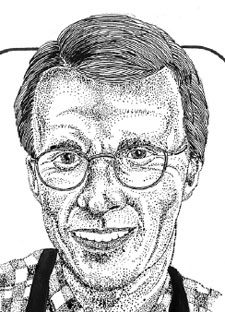 Tim Leatherman, founder and namesake of Portland, Oregon’s, Leatherman Tool Group, leader of a modern multi-tool movement that swept not only the knife industry but most of the world, is the 2006 inductee into the Blade Magazine Cutlery Hall Of Fame.
Tim Leatherman, founder and namesake of Portland, Oregon’s, Leatherman Tool Group, leader of a modern multi-tool movement that swept not only the knife industry but most of the world, is the 2006 inductee into the Blade Magazine Cutlery Hall Of Fame.
Enshrined during the BLADE Show’s BLADE® Magazine Awards Banquet Saturday night, June 17, in the John A. Williams Ballroom of the Cobb Galleria Centre in Marietta, Georgia, Leatherman took his rightful place with the other giants of the knife industry.
One of Leatherman’s fellow Cutlery Hall-Of-Famers, A.G. Russell of A.G. Russell Knives, introduced the new inductee to an audience of national and international knife professionals, knife enthusiasts, family and friends.
“I’d like to talk about missed opportunities,” Russell began. “I was at an NRA show in Seattle and this fellow comes up and he’s got an invention he wants me to sell. Well, it wasn’t a pocketknife, I didn’t recognize it as a pocketknife, and I missed an opportunity.
“Now, I’m not the dumbest person around. [Cutlery Hall-Of-Famer] Pete Gerber had an opportunity to buy [Leatherman’s business before it became well known] for a piddling sum, and he didn’t do it. [Cutlery Hall-Of-Famer] Albert Baer, who’s reputed to have been the smartest man this industry’s ever known, had an opportunity to buy [Leatherman’s] business, but he refused to come up with an adequate sum of money.
“So,” A.G. observed, “if ever again in another life I meet a gentleman who’s selling a new invention, I’m going to give it a lot more thought.”
Though often told, the story of the modern multi-tool’s beginnings bears repeating. Leatherman was an engineering graduate student traveling in Europe in 1976 when he experienced car trouble. He did not have the tools to make the repairs, so he invented what would come to be known worldwide as the Leatherman Tool and “thereby established a huge segment of the knife industry,” Russell noted.
Following A.G.’s introduction, the new inductee approached the podium to a thunderous ovation.
“It is truly an honor to join A.G. and the other great legends of the cutlery world in the Blade Magazine Cutlery Hall Of Fame,” Leatherman prefaced his remarks. “As for whether I’m one of those legends, I’m not so sure … But even if a person is not a legend, if a person is inducted into a hall of fame, you’d think that probably means he or she is famous, but in my case I’m not so sure that’s true, either.”
He related two incidents to prove his point, including the following.
“We were flying back to Portland,” Leatherman recalled, “and I was wearing a lapel pin on my collar, which the flight attendant recognized as a Leatherman Tool. She asked me if I owned Leatherman Tool Group. I said, ‘Yes. I’m one of the owners.’ I asked her how she knew.
“She said she lived in Portland and she recognized me from having seen my picture somewhere, maybe in the local paper or in one of the business magazines. ‘Maybe in the Fortune 500,’ she said jokingly, to which I could only respond, ‘I wish.’
“But isn’t that the great thing about the cutlery industry?” Leatherman posed the rhetorical question to a receptive audience. “None of us have made the Fortune 500 and, for most of us, it would be beyond our wildest dreams to think that we could, but we are doing the thing that is most important of all—having fun doing what we do.”
Many in the banquet hall murmured in agreement.
“It is quite an honor to be recognized tonight, but I think you are honoring me for more than just being the designer of the original Leatherman Tool,” he noted. “I think you are also honoring me for all the other tools that Leatherman Tool Group has introduced, tools such as the Leatherman Super Tool, the Micra, the Wave, the Juice series, the Squirts, the Charge and, most recently, our folding knives.
“But for those we must honor someone else, someone in attendance tonight … the world’s greatest multi-tool designer, Ben Rivera.”
Rivera stood to be recognized at the inductee’s behest and was greeted with a loud burst of applause. Leatherman then related a story about how his wife, Chau, who also was in attendance, was so crucial to the creation of the first modern multi-tool.
“By the time we got back in 1976 from our nine-month sojourn in Europe, I had explained to her my idea for a pocketknife with pliers, and I asked her if I could make one, just one, just for me, before I went out and got a real job. Of course, I must confess, even then I had the thought that if I liked it, maybe others would too, and maybe I could create a business out of it.
“But this fine lady had only one question,” he recounted. “She asked, ‘How long will it take?’ I said, ‘Oh, maybe a month.’ She said, ‘OK,’ and went to work to support us, and I went to the garage and picked up a file and hacksaw and tried to build what was in my mind.
“Three years later”—Leatherman grinned and the audience laughed in appreciation—”I had a prototype I liked but no one else did, so then I spent another five years looking for a customer, during which I modified the tool and finally came up with the features and the price and the quality that the market wanted. And in all that time her faith in me never wavered.”
Leatherman concluded with his own assessment of Leatherman Tool’s standing in the knife community.
“Back in the early days, there was a question of whether Leatherman tools were even considered part of the cutlery industry,” he noted. “In my mind I developed a pocketknife with a pair of pliers, but the public saw it as a tool with a knife blade. “But with this award tonight, the question of whether Leatherman tools are considered part of the cutlery industry has been definitively answered. And I’d like to thank you for welcoming me into the place I always considered home.”
Dan Dennehy (2007)
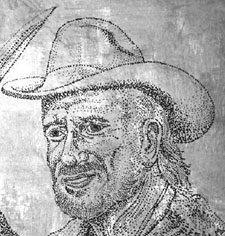 Following the BLADE® Knife Of The Year Awards Banquet at the 2007 BLADE Show in Atlanta, one observer was heard to say, “It’s nice to see somebody go into the Cutlery Hall Of Fame who really appreciates the honor.”
Following the BLADE® Knife Of The Year Awards Banquet at the 2007 BLADE Show in Atlanta, one observer was heard to say, “It’s nice to see somebody go into the Cutlery Hall Of Fame who really appreciates the honor.”
The “somebody” is Dan Dennehy, the latest inductee into the Blade Magazine Cutlery Hall of Fame. Of course, it is not that the previous inductees did not appreciate being inducted—far from it—it is just that Dennehy’s poignant acceptance speech was one of the most heartfelt in the hall’s history.
In his speech inducting Dennehy, Hall-Of-Famer D’ Holder set the tone in the Renaissance Waverly Hotel’s Grand Ballroom by noting that the enshrinee has been making knives for 65 years.
“He made his first knife while serving in the Navy,” Holder noted. “During those early years he discovered a material used for jigs, fixtures and brackets in the shipyard, and soon realized the value of this indestructible material called Micarta®. He shared the material with several other makers, including Bo Randall, John Nelson Cooper and Bob Loveless.”
After serving 30 years in the Navy, Dennehy settled in Yuma, Arizona, where he set up shop as a full-time knifemaker.
“He is a founding member of the Knifemakers’ Guild and wrote a good part of [the Guild’s] bylaws,” Holder continued.
In 1976, Dennehy moved to Del Norte, Colorado, where the Dan D knife shop has been ever since. There have been many highlights in the 84-year-old Dennehy’s long career, including having one of his bowies on display at the Alamo and his long involvement with knife throwing, including a number of years conducting the BLADE Show’s knife- and tomahawk-throwing seminar, culminated by his induction into the International Knife Throwers Hall Of Fame in 2003.
However, Dennehy wanted to talk about his family—most of the Dennehy clan it seemed attended the banquet, including his son, Lt. Col. Kevin Barry Dennehy of the U.S. Army Special Forces, fresh off a military stint in Afghanistan—and the friends the inductee made along the way. Those friends include his former-apprentice-turned-Dan-D shop foreman, Neil Lindsay, the aforementioned Holder, Randall, Cooper and Loveless, as well as Cutlery Hall-Of-Famer A.G. Russell, Daryl Meier, deceased knifemakers Clyde Fischer and Merle Seguine, knife thrower Bob Karp and others.
“I am truly honored and, at the same time, humbled to be included in the most exclusive organization in the United States,” Dennehy began, ignoring failing health to relish his moment in the sun. “This has got to be a very closed club: 43 members. I am honored to be No. 44 included in this group, [people] like Bo Randall, Bob Loveless, Bill Moran, Jim Bowie—how about that!—Col. Rex Applegate, D’ Holder and A.G. Russell, just to name a few. It makes the hair stand up on the back of my neck, and I wish to hell I could grow some on the top of my head.”
Concluded the enshrinee, “This is the crowning jewel of my life.”
Of all the inductee’s shared memories, it was his recollection of his first meeting with Randall that resonated most.
It was 1942 and Dennehy was a 19-year-old sailor and fledgling part-time knifemaker stationed in central Florida. One day, unannounced, he decided to visit a knifemaker— Bo Randall—who had a shop a few miles north of Dennehy’s duty station. Dennehy hitched a ride to Orlando, where he came upon the Randall shop “in the middle of an orange grove.”
It was a meeting that would change Dennehy’s life forever.
“I knocked on the door and this distinguished-looking gentleman came out and said, ‘Yes, what can I do for you, sailor?’ And I had the audacity to tell him that I was a knifemaker!’” Dennehy told an appreciative banquet audience. “And I want to talk knives with you!”
Unfortunately, the distinguished gentleman—who, of course, was Randall—said he had a houseful of company at the time and could the young man come back later?
Dennehy apologized profusely and turned to leave when Randall asked him where his car was. When Dennehy said that he had hitchhiked, Randall said, “My God, you [hitched a ride] all the way up here? Come on, let’s go out in the shop.” When Dennehy asked, “What about your company?” Randall replied, “They’re just a bunch of civilians. Let’s go out in the shop.”
Randall asked his visitor what he had in mind. Dennehy said he had just started making knives and would like one of Randall’s blades so that he could put one of his own handles on it. Randall agreed and Dennehy picked out a Randall No. 1 All-Purpose Fighting Knife.
“He grabbed hold of the knife, lit up the forge and put the knife in there. While things were heating up, we talked knives and I asked him about the secrets of making knives. He said there are no secrets, there’s just basic stuff that everybody knows and anybody who tells you there’s a bunch of secrets is just giving you a line,” Dennehy recalled. “In the meantime he forged this knife out for me and heat treated it, polished it and said, ‘There it is,’ and this is done by the master himself and I’m sitting there watching him! And I carried that knife all over the Pacific War and it served me well. And I wish I had kept a receipt that he charged me for that—$8.50—$8.50 for a handmade knife from the master himself.”
What any red-blooded knife enthusiast wouldn’t give to have been a fly on the wall watching and listening to those two knife legends swap lies!
Today, when time and his health permits, Dennehy continues to help oversee his Dan D knife shop, with the invaluable aid of Lindsay, whom Dennehy repeatedly credited with keeping Dan D Knives in operation in recent years.
Perhaps D’ Holder summed up the 2007 enshrinee best: “He helped blaze a trail for all of us who followed. He is truly one of the founding fathers of modern knifemaking.”
Ken Onion (2008)
 Ken Onion, inventor of the SpeedSafe assisted-opening mechanism, one of the world’s best-known and most successful custom knifemakers, a benefactor of the Paralyzed Veterans of America and other worthy causes and much more, is the 45th member of the Blade Magazine Cutlery Hall Of Fame.
Ken Onion, inventor of the SpeedSafe assisted-opening mechanism, one of the world’s best-known and most successful custom knifemakers, a benefactor of the Paralyzed Veterans of America and other worthy causes and much more, is the 45th member of the Blade Magazine Cutlery Hall Of Fame.
Bestowed at the Blade Magazine Awards Banquet the evening of May 31 during the 27th Annual BLADE Show, the honor was a complete surprise to Onion as he sat at one of the front tables in the Grand Ballroom of the Renaissance Waverly Hotel in Atlanta, along with his friends and co-workers of Kershaw Knives.
Not only is Onion the youngest member of the Hall but his meteoric rise to cutlery acclaim in such a relatively short time as compared to his fellow Hall Of Famers—he was basically an unknown when his Random Task assisted opener for Kershaw won the Blade Magazine 1998 American-Made Knife Of The Year®—is unprecedented.
Those in the Grand Ballroom rose as one in a standing ovation upon the announcement of Onion’s induction, and many rushed to embrace the honoree and ask him to autograph their Onion-designed knives after the banquet’s conclusion.
“This is the most incredible honor I’ve ever had; I’m at a loss for words,” an emotional Onion told the gathering of knife industry professionals and others after his induction by fellow Cutlery Hall-Of-Famer Frank Centofante. “The members of the Cutlery Hall Of Fame are my heroes. This is a huge honor. To be a part of this organization is the biggest honor that anybody could give me.”
A good friend of the honoree’s, Centofante recounted many of the high points of Onion’s career.
“In 1989, Ken’s wife, Noel, made arrangements through a friend for Ken to meet the great custom maker in Hawaii, Stanley Fujisaka,” Centofante said in his induction speech. “Ken and Stanley became friends and Ken learned his basic knifemaking skills from Stanley.
“Recently, when I was in Solvang, California, I had dinner with Stanley. Ken’s name entered the conversation and I could see a smile come over Stanley’s face. And Stanley said, as a proud mentor would say of his student, ‘That’s my boy.’”
In 1996, Doug Flagg, then with Kershaw Knives and now vice president of sales and marketing for Columbia River Knife & Tool, went to Hawaii to call on a Kershaw account. While there he discussed a potential working arrangement with Onion for the assisted-opening mechanism.
Soon after, Kershaw’s Jack Igarashi and Pete Kershaw signed Onion to a contract.
Back then, Kershaw was small with a vast majority of its knives made out of house, Centofante noted. Over the next five years the company would grow to well over 100 employees, and the number of high-quality knives would skyrocket inside a manufacturing facility that became one of the most modern in the industry.
“Ken Onion’s locking mechanisms, fabulous designs and contributions in manufacturing, teaching and marketing have helped to increase product quality and led to the growth and success of Kershaw,” Centofante continued. “And the company is still expanding under the leadership of Jack Igarashi.”
Onion was instrumental in getting Kershaw to donate a portion of the profits from its Zero Tolerance knives, which the honoree helped design, to the Paralyzed Veterans of America (PVA).
“Ken wanted to give back to the people who put their lives on the line,” said Joe Fox, immediate past president of the PVA. “Kershaw stepped in and said, ‘Yeah, we’ll do that,’ and he took it to them and they said yes and contributed to the PVA’s outdoor recreation fund.”
Fox was among the PVA members—the others were U.S. Army MSG Al Evans (retired) and U.S. Army SSG Hector Marquez—who participated in the presentation ceremony for the Blade Magazine 2008 Knife-Of-The- Year® Awards during the banquet.
Centofante went on to talk about Onion’s over 36 patents on various knife locking mechanisms, “fabulous knife designs” and more.
Concluded the inductor:
“Most importantly, Ken is a good person. He is honest and a man of the highest integrity. He is a person who keeps his word. Talking to Ken about knives is like being on a train going 100 miles per hour and trying your best to catch the scenery going by the windows. He is so enthusiastic and has so many ideas. All I can say is if you thought the last five years were something then just wait, because the best is yet to come.”
Al Mar (2009)
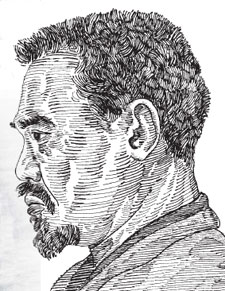 As someone once said, the best things are worth the wait, and so it was when Al Mar became the 46th member of the Blade Magazine Cutlery Hall Of Fame.
As someone once said, the best things are worth the wait, and so it was when Al Mar became the 46th member of the Blade Magazine Cutlery Hall Of Fame.
Announced during the Blade Magazine Awards Banquet at the 28th Annual BLADE Show, Mar’s posthumous election followed years of his finishing near the top of the voting by sitting Cutlery Hall-Of-Fame members. This time he would not be denied.
Mar started in the cutlery industry in 1968 in the employ of fellow Cutlery Hall-Of-Famer Pete Gerber at Gerber Legendary Blades. Mar designed knives for Gerber until 1977 and, in 1978, founded Al Mar Knives.
“His knives set a new standard in design and quality,” observed Mar’s good friend and inductor, Cutlery Hall-Of-Famer Sal Glesser. “He raised the bar to a level unseen before in production knives. He was the beginning of what was to become the specialty knife industry.”
Indeed, two of the winners of the Blade Magazine 2009 Knife-Of-The-Year® Awards who accepted the honors later during the banquet, Chris Reeve of Chris Reeve Knives and Matt Conable of William Henry Knives, credited Mar with being an inspiration for them making knives.
It was a homecoming of sorts for Mar’s daughter, Ryanne Mar Lukin, who worked for her father at Al Mar Knives for several years and accepted on his behalf.
“My father was passionate about knives and he would be very proud of this honor,” she said.
As Glesser noted, Mar was a multifaceted man. He was a Green Beret, a paratrooper and trained with counterterrorism units long before terrorism was the catchword it is today. He was a sworn deputy in several states and an accomplished martial artist, holding a 5th degree black belt in Judo. He also trained in Jeet Kune Do, Kendo and various Philippine martial arts styles. However, his creative side is his legacy.
“He was an artist, a master painter, working in charcoal, oils, water colors and, eventually, steel,” Glesser observed of Mar, who also drew the lifelike illustrations of the knife models that appeared in his company’s catalogs. “The rare sensitivity and depth shown in his paintings also showed in his knife designs. He earned his master’s degree in industrial arts and graphic design at the esteemed Art Center in Los Angeles. Highly sought after because of his unusual skills, he designed everything from cigarette lighters to speedboats… He was one of those rare, creative people that could bring beautiful and functional form to products.
“He was a dedicated family man. Married to Anne, they had one daughter [due to health concerns, Anne was unable to attend the induction ceremony]. Throughout his career, in all that he did, his family was always thought of first. They worked by his side in business, traveled with him in promoting and stood by him in all that he accomplished.”
It was in a Denver knife shop called “Knife World” owned by Joe Davis that Mar’s knives first came to Glesser’s attention in 1978.
“The lines of the knives were exquisite, different sizes, but all with the same basic design. Each knife was a piece of art in itself,” he recalled. “The grinds were flawless and the most effective shape for cutting and piercing. The interface between the lock and the blade was such a good fit that it was almost invisible to the eye. The long satin stainless bolsters met the polished white paper Micarta® scales at the center of the Al Mar front lock. They had a quality in fit and finish I’d only seen in custom handmade knives.
“I guess I was always a knife nut. I had a Buck 110 the year they came out and the Gerber folding hunter not much later. Al Mar’s knives were different. The front lock not only demonstrated very close tolerances but it also permitted one-hand closing, a feature that was not common back then, especially on production knives.
“Al Mar always gave [custom knifemaker] Harvey McBurnette credit for teaching him the front lock,” Glesser maintained. “It was an innovation that brought a new dimension to folding knives at the time. Naturally, I walked out of Joe’s shop with my new Al Mar Falcon, the first of many of Al’s designs I would come to own.”
While he designed and produced a wide range of fixed blades and folders, Mar’s most significant knife was the SERE lockback, considered by many to be the prototype of the modern tactical folder.
Glesser met Mar at the 1979 SHOT Show in San Francisco, where they became friends.
“We spoke of edges, designs and sharpeners for many hours over the years. I really learned a lot from that man,” Glesser said.
In 1980, Glesser devised the idea for what would become his now famous Clipit design—with the trademark hole in the blade and pocket clip—and he wanted Mar’s input.
“I showed him drawings of my knife design. I asked if we could use his front lock geometry for [it]. He looked at the drawings, looked at me, looked at the drawings again and he said, ‘Sal, it’s butt ugly,’” Glesser remarked to good-natured chuckles from an attentive banquet audience. “‘It’ll never sell, but if you want, I’ll help you produce it.’”
“Along with being the father of the specialty knife industry and bringing production knife quality to a new level, Al had a thread of gold that always shined. He shared knowledge with competitors,” Glesser noted.
Mar worked closely with such makers as Bill Buchman, Bill Harsey, R.D. Miller, Kuzan Oda and Butch Vallotton, as well as Cutlery Hall-Of-Famer Rex Applegate.
“He took me by the hand and helped us create the first Clipit knife,” Glesser continued. “He showed me his lock geometry and gave us permission to use his lock. He introduced us to the right people, said the right words so the right people would assist, and the rest is history.”
Mar’s reputation extended beyond the knife industry. At the SHOT Show in particular, his booth was a kind of “old home week”—virtually wall-to-wall throughout the event with friends and supporters.
“I was always amazed at the people that he knew and the many people that he’d helped along the way,” Glesser said.
Mar was well regarded in the law enforcement and military communities and was an avid gun enthusiast.
“Al had some guns, the kind gun guys sit in awe about,” Glesser explained. “He always supported and sponsored shooting teams. He said he … was always proud that his teams were among the best.”
When Mar passed away much too soon at age 54 in 1992, the cutlery industry was stunned.
“The knife world lost a great man,” Glesser said. “Hundreds from all over the world showed up for Al’s memorial. The line of people took hours to pass by.”
Better late than never, the Cutlery Hall Of Fame adds a most deserving member to its ranks: Al Mar.
Paul Bos (2010)
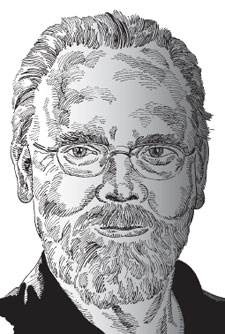 Perfect timing has always been important to Paul Bos. From knowing exactly how long to heat treat knife blades to exactly when it is time to call it a career, he seems to know the best time for everything. In fact, at the BLADE Show & International Cutlery Fair, just four days after his retirement from Buck Knives, the timing could not have been better when he was inducted into the Blade Magazine Cutlery Hall Of Fame.
Perfect timing has always been important to Paul Bos. From knowing exactly how long to heat treat knife blades to exactly when it is time to call it a career, he seems to know the best time for everything. In fact, at the BLADE Show & International Cutlery Fair, just four days after his retirement from Buck Knives, the timing could not have been better when he was inducted into the Blade Magazine Cutlery Hall Of Fame.
The first full-time heat treater ever to be inducted into the Hall, Bos has heat treated the blades of many of the most important people in modern knife history. From the custom knives of Cutlery Hall-Of-Famer Al Buck in the 1950s, to Cutlery Hall-Of-Famer Bob Loveless and other legends of the Knifemakers’ Guild in the ’70s, to today’s leading makers and, of course, Buck Knives, Bos has heat treated the blades of just about them all. It was only fitting that he be inducted by his former boss and now fellow Cutlery Hall-Of-Famer Chuck Buck during the Blade Magazine Awards Banquet the Saturday night of the show.
“No one can match Paul’s dedication to the art of heat treating knife blades or his unwavering commitment to supporting custom knifemakers worldwide, answering their questions about hardening and tempering blade steels, as well as tests and other needs,” Buck told the banquet audience. “He is living proof to the conviction that it takes more than just using good steel for making a fine blade; it’s what you do with the steel that makes the difference.”
Afterward, the latest inductee said the entire ceremony was like a dream—a dream come true.
“I was in a daze. I remember about every other word I said,” the soft -spoken Bos said of his acceptance speech. “When I got off the stage, [Cutlery Hall-Of-Famer] Ken Onion hugged me and that brought me back to reality some.
“I couldn’t have asked for a better career. I’ve been blessed. I wish I could do it all over again. I was joking with my wife, Sallie, that maybe I’ll be like Brett Favre and make a comeback.”
Bos has been heat treating steel in one form or other for over a half century. In 9th-grade metal shop class he made some cold chisels, heated them and watched them fracture when cooled rapidly in a water quench. He soon learned the need to cool the steel gradually in an oil quench. While still in school he worked four years for a heat treater for no pay—no pay other than learning how to heat treat steel.
Bos loves drag racing—he doesn’t race anymore but still owns two hot rods, both of which he said will be featured in an upcoming issue of Rod & Custom Magazine—and one of his dragracing buddies was Frank Buck, Chuck’s brother.
It wasn’t long before Bos was heat treating Al Buck’s custom knives. In 1969 Bos and a partner started a heat-treating company and, in ’71, Bos attended his first Guild Show. He would eventually strike up friendships with Loveless, Ted Dowell, Jim Nolen, and Cutlery Hall-Of-Famers Buster Warenski and Frank Centofante, heat treating their blades and those of many others—by one estimate, about 70 percent of U.S. makers—for the lion’s share of the next four decades.
In the late ’70s Bos helped Buck set up its own heat-treat department. Later, the two reached an agreement enabling Bos to operate his heat-treat business in the Buck plant. In 2001, he sold the business to Buck but stayed on as the company’s full-time heat-treat consultant.
Contemporary makers who have used Bos for their heat-treating needs include Strider Knives, Simonich Knives, Ken Onion, Tom Mayo, Trace Rinaldi, BLADE® field editor Wayne Goddard and many more, some going so far as to have their blades stamped with the famous Bos “flame” logo to indicate who heat treated them.
Though Bos has officially retired to spend more time with Sallie and their grandchildren, hang out with his old hotrod buddies and treasure hunt in Prescott, Arizona, he continues in an advisory role for Buck and visits the company’s Idaho plant as needed. He said he also will continue to entertain technical questions at his e-mail address of paulbos@buckknives.com, and, when possible, will appear at the Buck booth at future BLADE Shows and SHOT Shows.
Carl Elsener III (2011)
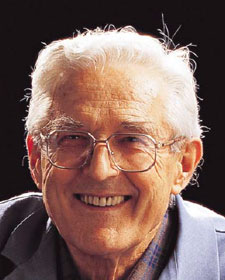 Carl Elsener III of Victorinox, the person most responsible for the unprecedented success of the world’s most recognizable knife, is the latest inductee into the Blade Magazine Cutlery Hall Of Fame.
Carl Elsener III of Victorinox, the person most responsible for the unprecedented success of the world’s most recognizable knife, is the latest inductee into the Blade Magazine Cutlery Hall Of Fame.
Officially enshrined June 11 during the Blade Magazine Awards Banquet of the 2011 BLADE Show, Mr. Elsener was unable to attend. However, his son Charles Elsener Jr., Victorinox CEO, accepted on his father’s behalf, and Cutlery Hall-Of-Famer Tim Leatherman of Leatherman Tool Group gave the official speech inducting the enshrinee.
As one sitting Hall Of Famer noted in the nominating and balloting process for this year’s induction, adding Carl Elsener “to our prestigious Hall Of Fame will make us an international group.” If he is right, it appears the Hall just went global—and it’s about time.
The Swiss Army knife is an icon, Leatherman observed, and so is Victorinox.
“The knives and companies don’t become icons by themselves. It takes people, and in this case I’m sure it took many people,” he said. “But the person most responsible is the man who has led Victorinox for over 50 years, who’s worked for Victorinox for over 70 years—next year, he will be 90 years old—Carl Elsener III.”
The inductee joined the company in Ibach, Switzerland, an area the Swiss government has officially designated the “Swiss Knife Valley,” in 1939 when he was only 16. In 1950, he was thrust into the leadership role when his father died prematurely. At the time, Victorinox employed 230. World War II, during which scores of American soldiers stationed in Europe “discovered” the little red-handle knife with the blades and tools and bought them in droves in the years that followed, was still in the rearview mirror. Mr. Elsener adopted modern manufacturing methods and made them work.
By 1984, on the company’s 100th anniversary, Victorinox employed 810. Despite airlines banning knives—most of which were SAKs—from carry-on after the 9/11 terrorist attacks, in the past few years company employment in Switzerland alone grew to over 900. In 2005, Victorinox acquired its main SAK competitor, Wenger. And on the 125th anniversary of Victorinox in 2009, the company employed over 1,700 worldwide, including those at the North American headquarters and official distribution center of Victorinox Swiss Army in Monroe, Connecticut. Through it all, Carl Elsener III has been an inspiration.
“He has an engineering mind. He’s a prolific inventor. His name is listed on many patents. He’s hands on, a detailed person, a perfectionist. When I met him in 2001, he had four pens or pencils clipped to his shirt pocket. In my mind, that’s a good thing. The more the better—I only have three,” Leatherman quipped.
“[My father’s] life has been Victorinox, and his passion the Swiss Army knife,” Charles Elsener stressed. “He has worked hours and hours for more than 70 years to make this little red knife better and better, and more functional. He was always open to the spirit of changing times—a very good example [being] one of the latest products, the Victorinox Flash with USB memory drive. It’s a unique combination of the heritage and tradition with modern technology.”
Under his father’s leadership, Charles Elsener said Victorinox grew from $205 million in sales to more than $500 million. As of this writing, Victorinox produces over 100,000 knives per day.
“Swiss knives are the epitome of quality and precision,” Leatherman added. “I’ve never ever seen a cosmetic blemish on a [Victorinox] Swiss Army knife.”
Today, Carl Elsener lives close to the factory and, until age 86, rode his bicycle to the office everyday. Even now, approaching 90, he still comes to work three or four times a week.
“Despite his success, my father has stayed grounded,” Charles Elsener said. “The most important values in his life have always been mutual respect and trust, courage, gratitude and humility. I have also learned from my father that the company who wants to stay successful in the long term basically needs to concentrate on three things—the people, the customers and the products. He embraced [that concept] very nicely.
“He said be close to your people, be close to your customers, be close to your products. When you do these three things right, not too much can go wrong.”
Kit Carson (2012)
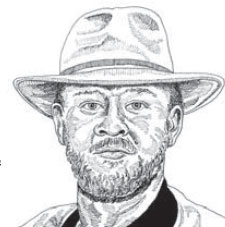 Teacher, mentor, retired Army master sergeant and friend to the knife industry, knifemaker Harold “Kit” Carson became the 49th member inducted into the Blade Magazine Cutlery Hall Of Fame during the 2012 BLADE Show at the Cobb Galleria Centre in Atlanta.
Teacher, mentor, retired Army master sergeant and friend to the knife industry, knifemaker Harold “Kit” Carson became the 49th member inducted into the Blade Magazine Cutlery Hall Of Fame during the 2012 BLADE Show at the Cobb Galleria Centre in Atlanta.
Formally inducted by his friend and fellow Cutlery Hall-Of-Famer Ken Onion during the Blade Magazine Awards Banquet on show Saturday night, June 9, Kit was unable to attend due to health concerns. Accepting on his behalf was another of his many industry friends, Rod Bremer of Columbia River Knife & Tool.
Kit is probably best known for helping popularize the flipper style of folder and for his M16 folder, and also his M4 and M21. The latter three knives have been reproduced by CRKT in factory/custom collaborations, the M16 in 20 different iterations in the current CRKT catalog alone. He also collaborated with Roy Helton on the CrossLock for Buck in 1996. Kit designed the Intrepid for Buck and also the Magna folder for Outdoor Edge.
However, as much as he is revered for his knives, perhaps his most lasting contribution is his willingness to teach any and all how to make them. Combined with the timing of it—when knives and knifemaking exploded on the Internet circa the late 1990s/early 2000s—his mentoring benefited perhaps as many new and upcoming potential knifemakers as anyone before or since.
“This isn’t about how wonderful his knives are—though they are impressive—it’s not so much about his 40 years as a custom knifemaker, not about his military service, though he did spend 20 years in the Army, retiring in 1993 as a master sergeant,” Onion began in his induction speech. “It’s not so much his collaborations with factories, though they are impressive. It’s about one of the most beloved custom knifemakers ever, a true ambassador of the handmade knife and this industry, a man who deeply loves his craft, this group of enthusiasts here tonight, and spending the last four decades selflessly teaching and promoting his craft to any and all who wish to learn.
“The list of makers he’s taught, encouraged and promoted is impressive and includes names like A.T. Barr, Jerry Corbin, John Greco, Jim Smyth, Jon Graham, Jerry Hossom, Marty Young and Brian Fellhoelter, to name a few. He’s just one of those guys who loves to help everyone around him, to help new guys refine their techniques, find their footing or learn a few new tricks, to encourage the new or old makers with his ‘C’mon in guys, take your shoes off and sit a spell’ personality, his calm demeanor, and his caring and nurturing nature. It is no wonder he is so admired.
“He took me under his wing when I was just a snot-nosed little punk knifemaker and taught, encouraged and congratulated me for my entire career,” Onion continued. “This guy is also a patriot, an amazing patriot. I’ve known him for as long as I’ve been making knives and he’s been sending a good amount of his custom knives to active duty servicemen without asking anything in return, just doing the right thing for the right reason. He’s definitely a lead-by-example kind of guy. He also supports many veteran and law enforcement charities every year. I can think of no one more deserving, no one that emphasizes the purpose and meaning of the Hall Of Fame more so than my friend, Mr. Harold ‘Kit’ Carson.”
Accepting on Kit’s behalf, Bremer recalled a special meeting with the inductee.
“The first BLADE Show we attended as CRKT was in 1996. Kit came to our table and he talked to me and I was blown away that he even gave us the time of day,” Bremer said. “He offered up a fixed blade to us that was a killer design and I was mesmerized because that was back in the day when he [helped develop] the Cross-Lock for Buck. I was thrilled he gave us any attention whatsoever, but that’s the kind of guy Kit is.
“I brought the knife back to my old partner and I said, ‘Kit Carson has given us this opportunity to do one of his designs.’ I was so excited but we didn’t know what to do with it. It was clearly not something we could do a good job for him on, so we didn’t know how to say no thanks because it was Kit Carson. We said, ‘Kit, we can’t do this knife justice.’ We were honest with him and I believe he did it with Buck and it was a big success and they had the right horsepower to do it, and we didn’t at the time. What’s very cool about Kit was he didn’t throw us under the bus for that.
“A couple years later at a Guild Show we looked on the corner of his table and there was his M16 and I thought, ‘Man, that is just too good to not try one more time to see if we couldn’t put something together with him.’ And you know, that’s the bread and butter for CRKT, one of many, and that’s just a little snippet of the kind of guy Kit Carson is,” Bremer concluded.
Noting that Kit was struggling with his health, he added, “But he’s going to be good and his spirit is always good.”
Bremer then read the following statement prepared by Kit.
“It’s indeed an honor and privilege to stand before you tonight to fulfill another goal in my life’s journey with a totally unexpected honor—to be inducted into the Blade Magazine Cutlery Hall Of Fame. Understanding that only one individual is selected each year makes this an even more special event for me.
“Having grown up not far from here in North Georgia, I’ve always been interested in anything mechanical. I’ve carried that fascination to find innovative and creative things, to make things work better throughout my life. After high school I served a four-year apprenticeship here in Atlanta, finishing in 1972. That year I started making knives and was also drafted into the Army. I served in numerous positions throughout Europe and the United States.
“It was during my last 10 years in the Army that knifemaking became extremely interesting and a challenging hobby. Those were extremely rough years, long hours as both a soldier and knifemaker while always trying to ensure that our kids had a sandwich and a lunchbox. I was working in small sheds, basements and garages, or wherever I could find space in government housing, apartments and houses, to grind a blade shape or handle, or try to figure out how a locking mechanism worked.
“If it weren’t for the love and patience of my bride, Miss Betty, children Jody and Christy, or equally the friendship of folks like Bob Cargill to be there to answer questions, I would’ve never survived as a maker. It was the friendship of those like Bob, Ken Onion, Gene Baskett, George Young and Les Robertson, as that is what this craft is all about.
“We did not have the Internet, all the books or the specialty tools. Many of us still today do every piece by hand, filing, sanding, honing blades, slowly creating knives, spending hundreds of hours at knife and BLADE shows establishing our names in the industry and, most importantly, making lifelong friends.
“The profession of knifemaking ranks right up there with any profession that requires dedication, devotion, passion, honesty. It’s all about customer service and the pride of stamping your name on a blade which communicates to the world it’s something you’ve created. Regardless if it’s a unique custom, one-of-a-kind or production model that millions of copies were produced from, it’s yours, it’s who you are, it’s where you’ve been, and it’s your creativity and innovation. However, it must stand for quality.”
“I know there are no limits to this profession as to where it can go. Thanks to the Internet, our blog and forum sites, publications like BLADE® Magazine that support manufacturers like CRKT, Buck, Spyderco, to name just a few, coupled with the fact that knifemakers come from every background and every walk of life, the continued progressing of this profession is unlimited. Shoot, one could even argue that if you put a group of knifemakers, bladesmiths and collectors together, you could build a spaceship.
“I’ve pretty much dedicated the past 35 years of my life to our country and my family in trying to progress the profession of knifemaking throughout the world. The recognition of my dedication is extremely humbling, much appreciated and will never be forgotten. This is the highlight of my knifemaking life. I pledge to you all that I will continue to progress this profession through continued memberships of both young and old knifemakers—and we’ll see ya on the moon.”
Wayne Goddard (2013)
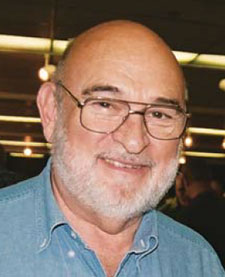 ABS master smith and BLADE® field editor Wayne Goddard has made knives since 1963—which makes this his 50th anniversary of knifemaking.
ABS master smith and BLADE® field editor Wayne Goddard has made knives since 1963—which makes this his 50th anniversary of knifemaking.
It’s fitting that he also became the 50th inductee into the BLADE Magazine Cutlery Hall of Fame in ceremonies held during the recent 2013 BLADE Show & Living Ready Expo. As his fellow Cutlery Hall Of Famers wrote, Goddard “is the dean of American Northwest bladesmiths. He has been a leader and an example to generations of knifemakers. He was a knifemaker when that meant ‘one of a few,’ when tools were only basic and it was all in the hands.”
“I consider myself fortunate to have started in the dark ages of knifemaking,” Goddard once said. “Those of us who were getting started in those early years used whatever we had and made the most of it. We had to be inventive problem solvers or else we wouldn’t have gotten too far. I believe that if you can’t learn to do something with simple tools, then all the fancy tools will not do much good.”
An example was his first knife. He made it from scratch from a lathe rasp on which he had drawn back the hardness.
“Our old Westinghouse washing machine wore out but the motor was good, so I made my first grinder out of it. It was a real piece of work,” he recalled. “The grinding wheel and adapter came from Sears, and the switch came from a secondhand store. An old cookie sheet was bent up and around to make a guard, and the whole mess was bolted down to an old bookcase. It was underpowered and ran too slow—but it did work well enough to grind out my first 20 knives.”
Goddard went on to make a number of award-winning custom knives, and also designed knives for Spyderco. He has held membership in the Knifemakers’ Guild and is a master smith in the American Bladesmith Society. He has taught forging, sharpening and other knife-related subjects at a variety of venues.
His columns for BLADE have included his “Question & Answer” for over 20 years, and also columns on blade steels, “$50 Knife Shop” and other features. He wrote influential stories on cable damascus in KNIVES ’86 and KNIVES ’87.
Among others, his books include Wayne Goddard’s $50 Knife Shop, The Wonder of Knifemaking and Wire Damascus Hunting Knife: How To Do It. His writings on the importance of testing, forging and how the proper heat treating of a steel can be as important if not more important than the steel itself have helped shed light on these three often misunderstood subjects.
Perhaps therein lies the key to Goddard’s genius. He was the product of an era when knifemakers guarded most of their methods like the Holy Grail, as if those methods were their secrets and their secrets alone. He was at the forefront of those who gave freely of the so-called secrets in the pages of BLADE long before the Internet made it fashionable to dispel the folly of such “secrets.”
And when the Internet came along, he embraced it and spread his knifemaking gospel online to budding knifemakers everywhere.
The past year or so has been a trying one for Goddard. He lost his wife and inspiration, Phyllis, and health problems precluded him from attending his induction ceremony. However, he was there in spirit. In a prepared statement, Goddard wrote:
“I regret that health issues have kept me from being here. I want to thank the members of the Cutlery Hall of Fame for this honor. It will help me celebrate 50 years as a knifemaker.
“It has given me great joy to have filled the role of knifemaker, writer and teacher. I have a lot to be thankful for.
“I visited Rudy Ruana in 1969 and it was quite inspiring to see a knifemaker turning out knives by the handful. He gladly answered all the dumb beginner questions I had, and that was a big help.
“In 1971 I got acquainted with Bob Loveless, who was helping get the Knifemakers’ Guild organized. I joined as an associate member and was at the 1972 meeting and show in Kansas City. There was one maker who wanted to keep me from getting a probationary membership because my catalog was not professional enough to suit him. First on his feet was Bill Moran to argue that the Guild shouldn’t monitor catalogs. The majority agreed with him and he became my hero. When the Guild voted on the rules, there was nothing about the quality of a maker’s catalog. I was accepted and got my voting membership in 1975.
“Bob Loveless was mostly misunderstood. He always took time to help new makers like myself, and was free and open with information. Don’t think for a minute that I was an exception—he probably got more makers started than anyone. He was a good example and I was fond of passing it on when it came time to share.
“My wife of 53 years, Phyllis, lost her fight with cancer in September. She was my partner in all we did and I couldn’t have achieved all that I’ve done without her. I wish she could be here to share the occasion.”
All who know Wayne and knew Phyllis wish the Goddards could have been at the banquet, too. However, as mentioned, they were there in spirit. And it is that spirit that sustained the custom knife industry in its infancy and continues to drive it today.
Goldie Russell (2014)
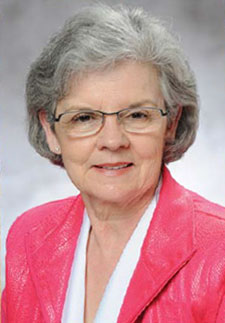 Mrs. Goldie Russell of A.G. Russell Knives made history when she was inducted as the first female member of the BLADE Magazine Cutlery Hall Of Fame.
Mrs. Goldie Russell of A.G. Russell Knives made history when she was inducted as the first female member of the BLADE Magazine Cutlery Hall Of Fame.
She joined her husband, fellow Hall-Of-Famer A.G. Russell, to become the Hall’s first married-couple members as well. Cutlery Hall-Of-Famer Bill Adams inducted Goldie during the BLADE Magazine Awards Reception at the 33rd Annual BLADE Show. It was one of the more popular inductions in Hall history and, as usual with most of the Hall’s inductees, Russell did not know she would be inducted until she heard the announcement along with everyone else on hand.
Obviously moved by the news and the thunderous ovation she received, she took a seat at the reception podium and listened as Adams outlined her stellar quarter century in knives.
Goldie met A.G. in 1982 through a mutual friend—A.G. had been looking for a dancing partner! Little did they know they would dance all the way to the Cutlery Hall Of Fame. A.G. took Goldie to the Knifemakers’ Guild Show in 1983 and she was duly impressed that there was a group of knifemakers working together through the Guild to promote their craft.
A.G. used Goldie as a sounding board as he developed ideas for his business. The two were married in 1988 and soon after she went to work for A.G. Russell Knives. Goldie had a background in art and English, and A.G. wanted her to help part time with catalog layout and advertising. It didn’t take long to realize it would be much more than a part-time position.
She moved into day-to-day management gradually. After a key employee left , Goldie had to assume administrative and marketing duties for the company. A.G. said it took two years to teach her everything he knew about the mail-order business and that she just kept learning from everyone, from printing company account executives to accountants and lawyers.
She became president of A.G. Russell Knives in 1995. She and A.G. ran the company jointly until A.G. suffered a heart attack in 2004. While A.G. recovered, Goldie took care of everything from choosing product to writing catalog copy to dealing with accountants and bankers.
When Goldie started work for A.G. Russell Knives in 1988, there were three office employees and A.G. Bob Dozier also worked there making Morseth knives. The total number of company orders processed that year was just over 12,000. In 1995, the company shipped over 99,000 orders. The same year, the Russells moved the company out of a small house and small block building in Springdale, Arkansas, and into an 8,000-square-foot structure.
They outgrew the latter by ’99 and bought land at the current location in Rogers, Arkansas, and the company moved again in 2002.
“By that time, Goldie had managed three remodeling jobs and built two new buildings for the company. She says that she began to feel like A.G. hired her as a general contractor,” Adams grinned.
In 2004, the company had 125,000 orders processed by 47 employees. Today the business operates with 37 year-round workers plus 18 temporaries during the Christmas season.
A board member of the American Knife & Tool Institute, A.G. asked Goldie to attend AKTI board meetings. Even though Goldie initially had little interest in the AKTI, she agreed. In 2007, the group found itself without a president or vice president, and Goldie was asked to take one of the positions.
She opted for the presidency, thinking whoever was vice president would take over in two years.
However, two years passed and there was no vice-president to assume the presidency, so Goldie stayed on for another term. During the AKTI board meeting at the 2009 BLADE Show, CRKT’s Rod Bremer told board members of U.S. Customs’ proposal to change the definition of a switchblade/automatic knife to include all assisted and one-hand-opening knives. If approved, the change would have outlawed all such knives and devastated the cutlery industry. The AKTI was fortunate enough to have Goldie at the helm at such a crucial juncture.
“In my opinion, Goldie’s real strength in helping the AKTI through this process was twofold—the fact that A.G. Russell Knives is not a manufacturer and so was not a competitor with most of the companies who were AKTI members,” Adams noted. “Instead, A.G. Russell Knives was a customer of every one of them, and Goldie knew them all well. The other thing is, she is no shrinking violet and was not timid about explaining her point of view and asking companies to participate.”
Goldie studied the Customs proposal thoroughly and understood its impact. She convinced those in the industry who thought the law would cover only imports that it would outlaw virtually all one-hand-opening knives. It was a key moment in enlightening the industry’s major players on what was at stake. And, in the end, Goldie was a key force in the resulting federal pre-emption that exempted assisted and one-hand openers from being defined as switchblades/automatics.
“From one who has spent many hours fighting against ill-conceived knife and gun bills,” Adams maintained, “this preemption of the law, done without any of the nasty, ugly, rock throwing that I was used to, was absolutely a stroke of genius!”
In her acceptance speech, Goldie downplayed her role in defeating Customs’ proposed definition change.
“I can’t take all the credit,” she said. “That was a real team effort to make that happen and there were lots of people involved. I did happen to be president of the organization at the time. I think I was able to lend an understanding that maybe other members didn’t have, that kind of experience to lend, and we fought a really interesting battle.”
She credited Bremer with notifying the AKTI and the rest of the knife industry of Customs’ proposal at the ’09 BLADE Show.
“We were all able to get together,” she recalled. “The industry did come together. It did take a little bit of convincing of some people that it was going to affect them as well, but in the end we all worked together to make that happen.”
Ironically, part of the credit for defeating Customs goes to Customs itself.
“Whoever wrote that regulation went way overboard and actually kind of dropped it in our lap because when we went to the legislators they were so overwhelmed at how stupid [the regulation] was,” Goldie explained. She said many trips by her and AKTI members to Washington, D.C., and talks with many important legislators played a pivotal role. However, it was an Arkansas senator who stepped up and said the law would be changed that was the key to stopping the Customs definition change.
“And that really happened because of A.G. and A.G. Russell Knives because we were able to get the senator’s attention and then luck was with us because he was the head of the chair of the appropriations committee for Homeland Security, so that all really fell into place,” she observed.
Goldie said she has many to thank for her induction, including A.G.
“You can’t do anything unless you have the vehicle to do it with, and A.G. provided the vehicle,” she noted. “I simply provided the organizational skills. He’s got the creative ability.”
She also thanked the staff of A.G. Russell Knives and the industry in general.
“And when I say the industry,” she stressed, “I’m not talking just about the manufacturers, I’m talking about the customers, collectors, folks like the Lorenzis from Italy, the knifemakers, the purveyors, all of us, this is our industry, it’s a marvelous industry, and it’s been a pleasure to work in it for 25 years.”
Chris Reeve (2015)
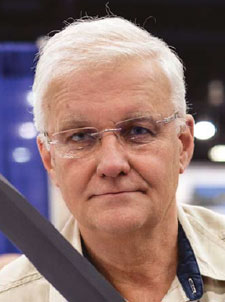 In his acceptance speech upon being inducted into the BLADE Magazine Cutlery Hall Of Fame during the 34th Annual BLADE Show & International Cutlery Fair, Chris Reeve recalled his wild and wooly motorcycle-racing days. One error hurtling along at speeds of 120 mph and up could mean disaster or death. As a result, everything about his motorcycle had to be just so—there could be no loose screw here or bad tire there. Everything had to be checked repeatedly to ensure safety and success.
In his acceptance speech upon being inducted into the BLADE Magazine Cutlery Hall Of Fame during the 34th Annual BLADE Show & International Cutlery Fair, Chris Reeve recalled his wild and wooly motorcycle-racing days. One error hurtling along at speeds of 120 mph and up could mean disaster or death. As a result, everything about his motorcycle had to be just so—there could be no loose screw here or bad tire there. Everything had to be checked repeatedly to ensure safety and success.
“The most I ever learned about business was when I was racing motorcycles,” he noted. “It was a cut-and-thrust, hurly-burly world, and in those days South African road races were some of the best in the world.”
It took a lot of chutzpah every time he got on his bike, in the back of his mind knowing this ride could be his last. However, each time he got back on the motorcycle. In a way, he’s been getting back on that motorcycle ever since.
“The other thing I learned is if you want to win, you must take care of the details,” he continued. “Any young maker who comes to me and wants to know what I think of his knife, I point out the details—you need to take care of this, you need to take care of that. You see this little nook and cranny here? The customer will see it—there are no ifs or buts or maybes, he will see it. And that’s what I’ve [stressed] with my staff down through the years. If you want to do well, you have to take care of the details. Everything is in the details.”
Knifemaker Bill Harsey delivered the induction speech as only a person who has worked closely with the inductee on a number of award-wining knives through the years can. Bill said the migration of early man to North America over the Alaskan land bridge and North Atlantic sea ice included many knifemakers—after all, the migrating humans relied on knives and had to make their own from whatever materials they could. And leave it to Bill to note that studies show 2 percent of the DNA of Northern Europeans tests for Neanderthal peoples.
“They test bladesmiths at around 27 percent,” he winked to the delight of the audience.
So, too, Harsey noted, did Chris and Anne Reeve “migrate,” bringing the knife operation started in a garage in urban South Africa in 1984 to Boise, Idaho, in 1989. They became naturalized American citizens and over years of hard work built their operation into the 40-employee, award-winning knife factory that it is today.
Along the way they amassed a record 14 BLADE Magazine Manufacturing Quality Awards—no one else is even close—a unique Knife-Of-Th e-Year® honor in that it recognizes a company’s entire line of knives rather than just one.
The fact Chris Reeve Knives won it again this year made Chris’s induction just that much sweeter.
Other of the company’s BLADE Magazine Knife-Of-The-Year Awards include the 2003 Collaboration Of The Year with Harsey for the Green Beret Knife; the 2005 Investor/Collector Knife Of The Year® for the 21st Anniversary Sebenza; the 2007 American-Made Knife Of The Year® for the Pacific; the 2008 Overall Knife Of The Year® for the Umnumzaan; the 2009 Kitchen Knife Of The Year® for the Sikayo 10-Inch Slicer; and the 2010 Overall Knife Of The Year for the TI-Lock.
Of course, these are Knife-Of-The-Year awards only; Chris won many more honors as a custom maker in his early years, and Chris Reeve Knives has won many other awards as well.
If you’re new to the knife industry and don’t know of the company’s penchant for giving knives what Harsey called “unpronounceable names” such as Umnumzaan and Sikayo—others include Mnandi, Uumfaan, Impofu and more—those monikers are in Zulu and honor the tribe of the same name in South Africa. Most famous of all is the Sebenza, an industry standard folder that popularized Reeve’s Integral Lock™—what many call the framelock—on folding knives of all stripes.
“When I first saw the Sebenza, it was the ugliest damn folder I’d ever seen,” Harsey told the audience. “After a few minutes, Chris Reeve’s design instruction started to sink in. This is a good knife? No, this is an amazing knife, maybe even a great one.”
As an aside and again to the audience’s delight, Harsey said, “Now I know what Sebenza means. Translated from Zulu, it means get your lazy ass back to work.” (Editor’s note: Actually, Sebenza means “work” in Zulu, but Bill’s definition wins the colorful metaphor award.)
Reeve’s blade brilliance didn’t happen overnight. Early on he served a traditional apprenticeship as a machinist in South Africa, and his first knives were super-tough integral models, many all black, of one solid bar of A2 tool steel.
Meanwhile, the role played by Anne cannot be emphasized enough.
“Anne Reeve is integral to Chris Reeve Knives. She’s been there the entire time taking care of the endless tasks and running the front side of the operation. She runs the joint; she is the boss. She also signs the checks,” Harsey quipped.
One thing evident about Chris is he is passionate about knives and the knife industry. He will be the first to admit that the fire of his passion runs a bit hot at times. He and Anne had to gamble on knife consumers being willing to pay unheard of prices for Chris Reeve Knives at a time when few factory knives cost more than $100. The Reeves succeeded but not without setbacks.
“We’ve all had pressures in production,” Harsey said to the audience composed in large part by factory professionals. “The financial pressures to stay in business are often the death knell to creative thinking and quality work. That pressure never goes away.”
Chris’s passion also resulted in his playing a crucial role in the acceptance by the entire knife industry of CPM S30V stainless steel—the first-ever steel made specifically for knives—in the early 2000s.
“Chris told me up front we would not keep secrets on how we heat treat these steels because we were trying to get the entire industry to use them, and to be successful with these steels [those in the industry] had to know how to handle them,” Harsey recalled.
Today, S30V is one of the knife industry’s most popular blade steels. Reeve also was instrumental in the acceptance of the newer CPM S35VN stainless.
Harsey summed Reeve up best when he concluded, “Individual knifemakers ultimately lead the way for the knife industry. Chris Reeve has done both, combining his vision with the ability to build and run his own manufacturing process, producing knives at a fairly high level of craft . Chris has always been driven to be the best he can—just like the other first knifemakers to arrive in North America.”
CJ Buck (2016)
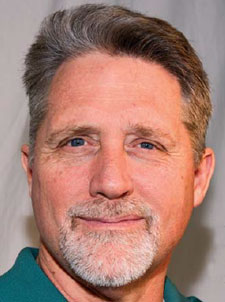 CJ Buck helped make knife history June 4 when he joined his father and grandfather as the only three generations of one family in the BLADE Magazine Cutlery Hall Of Fame.
CJ Buck helped make knife history June 4 when he joined his father and grandfather as the only three generations of one family in the BLADE Magazine Cutlery Hall Of Fame.
The 53rd member of the Hall, CJ was inducted by Jan Billeb of the American Knife & Tool Institute (AKTI) and Cutlery Hall-Of-Famer Goldie Russell during the BLADE Magazine Awards Reception the Saturday night of the 35th Annual BLADE Show. President and chief executive officer of Buck Knives, CJ joins his grandfather, Al Buck, and father, Chuck Buck, in the Hall.
Billeb praised the latest inductee for advancing the knife community through his contributions to the formation and work of AKTI.
“Over 18 years ago, [he] had the foresight and commitment, personally and financially, to ensure there is a forum for the industry to develop solutions to common problems,” she noted. “Without such an organization in place in advance, issues such as the 2009 U.S. Customs attempt to include assisted-opening knives in their definition of illegal switchblades would have destroyed a large segment of the knife community, and the current change in automatic knife laws in many states would not have been possible.”
Billeb lauded Buck for recommending in the AKTI’s formulative stages that the organization be multifaceted, that it be “about more than being reactive, but also proactive to protect our American heritage of knives in daily lives and promote growth in the industry, encouraging the next generation of knife owners.”
She added Buck was instrumental in determining AKTI’s position of knives being first and foremost a tool, “a position that resonates with legislators attempting to appease a broad range of constituents, a common-sense approach that has helped successfully develop reasonable and responsible knife laws and knife law enforcement.”
The AKTI executive detailed how Buck has elevated the knife industry’s image to the world at large as evidenced by how Buck and the AKTI are received by labor unions, congressional caucuses, and conservation and outdoor groups, as well as being cited in legislative and judicial documents.
Russell, the only female member—and, along with husband A.G., comprising the only married couple—in the Hall, was equally laudatory of the new inductee.
“He is the only person that has continuously and personally served as a board member of AKTI, contributing countless personal hours and expenses to do so. His leadership has created an environment of openness and sharing,” she observed. “His concern for the entire knife community is often demonstrated in AKTI meetings by making sure that the positions of all facets of the community, from user, collector, retailer, distributor, importer and manufacturer, are considered. [He] contributes to the knife community without any concern of recognition for AKTI’s efforts or his own. He exemplifies the criteria to be a member of the Cutlery Hall of Fame.”
In 1978, Buck Knives hired CJ to work on the company’s production line. For 21 years he handled numerous company promotions and responsibilities. In 1999 he was named company president and, in 2001, CEO. In 2015 he was named Buck chairman of the board. He is also a past president of the American Edged Products Manufacturers Association.
He is co-founder and current president of AKTI. He served as AKTI president and then president from 2001-03. Until this past year he served as the organization’s legislative committee chairman, a position he had to relinquish in order to properly fulfill his four-year commitment, beginning in 2013, as vice president and now president of AKTI.
CJ was unable to attend his induction because his wife was undergoing major wrist surgery. However, he provided a prepared statement read by Billeb, most of which follows:
“The Cutlery Hall of Fame includes individuals who have had such a strong and passionate impact on the industry I love, and the fact that those same individuals have accorded this recognition to me is almost overwhelming. “I was raised in the knife industry yet I know I have made fewer knives by my own hand than many in this room. Unlike my grandfather and father, I was never really a custom knifemaker. However, knives were a huge part of my childhood. Since I was a young child I have heard stories about how someone’s knife saved their life, was a cherished heirloom from a prior generation, survived a tour of duty, survived a divorce or a move, or, being forgotten, stuck in a tree for a winter or two on the site of a successful big game hunt.
“Tool, or weapon or both—what energizes me the most about knives is providing value and life solutions to our customers.
“Our industry and our products become a part of people on a very deep and personal level. We are invited to be co-adventurers, relied upon as work partners, and sometimes are cast as lifesavers. We commemorate key milestones, we inspire confidence, we protect, we enable and make so many life experiences possible.
“Those are big responsibilities and in reviewing the historical list of inductees there seems to be a common thread, a commitment to innovation and performance, and a comfort to being held accountable to both. I do not think that accountability appeals to everyone. There is a certain type of ‘salt-of-the-earth’ person that seems to be drawn to cutlery and if you look around you, you will see them. It is not a ‘light-duty,’ get-rich-quick scheme. It is a long-term commitment and focus with the satisfaction of staying the course.
“I am also proud of manufacturing. There is magic in taking a few dollars’ worth of raw materials and transforming them into something of utility and value. Whether it is millions of units or just one, making stuff is what made this country great and is what we need to encourage for all we are worth.
“I continue to enjoy my involvement with the American Knife & Tool Institute and am so pleased with how much progress we have made by working together. From the closed and short-sighted 1958 Federal Switchblade Act to the visionary Knife Owner’s Protection Act, we have brought outdoorsmen and women together with the building trades in a frank dialogue based on logic and reason, and not fear. We have partnered with legislators and law enforcement rather than just be adversarial and have brought about change in how knives are regarded. That momentum continues.
“I remain extremely proud to be a part of this industry, could not imagine myself doing anything else, and both of those facts makes this unexpected honor very sweet indeed.”
Jim Batson & Les de Asis (2017)
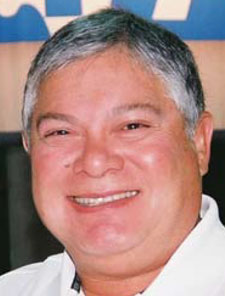
It was a family affair in a number of ways when Benchmade CEO Les de Asis and ABS master smith Dr. James “Jim” Batson became the latest inductees into the BLADE Magazine Cutlery Hall Of Fame during the BLADE® Magazine Awards Reception the Saturday night of the BLADE Show.
Unable to attend due to a previous engagement—a cruise to Hawaii with his wife Roberta in a joint celebration of their 65th birthdays—Les did the next best thing and sent his son Jon, who thanked the audience of knife industry professionals and enthusiasts on his father’s behalf in Ballrooms 1 and 2 of the show’s host hotel, the Renaissance Atlanta Waverly.
Lending moral support was a number of Benchmade employees who were on hand to help staff the company booth at the BLADE Show. Batson, meanwhile, brought a large part of his clan, including wife Barbara, son James L. Batson III, daughter Sara Beth Fair, grandchildren Luke, Andrew and Cole Batson and Bryant Fair, and, as Jim cracked, “even my ex-wife,” Sara Bryant Batson.
Introduced by Mel Pardue, who has designed Benchmade knives for many years, Jon read from his father’s prepared statement, thanking Roberta and their children, Jon and Melissa; the Cutlery Hall-Of-Fame members who supported Les’s nomination; BLADE Magazine and BLADE editor Steve Shackleford for their support of Benchmade knives over the years; and BLADE and the BLADE Show for their continuing support to expand and grow “this fabulous show into such an important international marketplace event.”
“Being inducted and proudly joining this extraordinary assemblage of craftsmen, artisans and business leaders is certainly the proudest moment and highest honor of my career,” Jon shared the words of his father. “I would like to dedicate this honor, first off , to my family, and to all of the fabulous people, past and present, who have worked with me shoulder to shoulder in making Benchmade Knife Company into the fabulous organization and community it has become, and especially to all those that carry, use, collect and support our products.”
Jon explained that his father visited his first custom gun and knife show in Glendale, California, in 1979 and met the craftsmen and marveled at the works they had made and offered for sale.
“I liked that they were independent and developed their skills by improving their products over time,” Jon related his father’s sentiments. “I also appreciated that they were independent and plied their skills in their home workshops.”
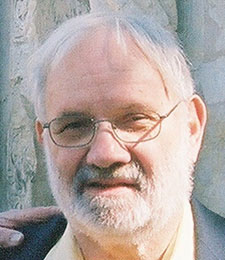
At the beginning of his career Les indicated he met pioneer knifemakers like Cutlery Hall-Of-Famer Bob Loveless, Barry Wood, Glen Hornby, Chuck Stapel and many more, talking knives and guns for hours at a time. Les visited their shops and learned how they worked, what their definition of quality was in regard to design, materials, fit and finish, walk and talk, and metallurgy.
“I have been constantly intrigued by all the personalities, processes, materials, artistry and innovation that are present in the custom knife world, and challenged in how to translate them into a unique, high-quality manufacturing environment able to serve an ever-growing customer base,” Jon shared his father’s words. “I confess, it wasn’t easy creating a world-class company but the journey, one knife at a time, was worth the effort!”
Les indicated the honor signified the highest achievement of his professional career.
After a moving introduction from one of the original four founders of the American Bladesmith Society and Cutlery Hall-Of-Famer B.R. Hughes, Batson pulled out his index cards with notes to touch on during his acceptance speech.
Like Les, Jim spent much of his talk thanking those in the industry who had played such a large role in furthering the art of bladesmithing, mentioning ABS master smith Jerry Fisk and especially Cutlery Hall-Of-Famer Bill Moran. Jim credited Moran with establishing any number of bladesmithing standards in knife judging, testing and other regimens, the Bill Moran School of Bladesmithing in Old Washington, Arkansas, and for inspiring bladesmithing schools in Clyde, North Carolina, and Auburn, Maine, as well.
“In summation, Mr. Moran is responsible for the present-day state-of-the-art of the forged blade, which has been highly developed,” Jim maintained. “I also would like to thank Billy Ray [B.R.] Hughes for his guidance, advice and friendship.”
It was at this point that Jim looked out at the audience and suggested, “We ought to have some hand claps along the way.”
Audience members tittered and let loose with a healthy round of applause.
“Each one of [my] statements was fairly profound,” he grinned, and the audience cracked up again.
Changing gears, Jim said, “Nearly everyone in this room is indebted to the BLADE Magazine in one way or another. The BLADE publishes your ads, writes about your knives, [promotes] the BLADE Show, [publicizes] knifemaking supplies and helps you sell your knives.
“I personally thank J. Bruce Voyles when he was BLADE Magazine owner for initiating these opportunities, and lastly I would like to thank Steve Shackleford for being more than just the editor of BLADE. This award will always have a place of honor in my home.”
Dan Delavan (2018)
Along with his wife Pam, Dan closed the Plaza Cutlery retail knife shop in the South Coast Plaza Shopping Resort in Costa Mesa, California in January after 44 years as one of the world’s most forward thinking of brick-and-mortar cutlery stores. Dan was in on the ground floor, helping his parents, Del and Lois, open the store in 1974.
From the outset, Plaza was a pioneer in selling knives in a mall setting and custom knives in general—the latter at Dan’s insistence and something only a handful of stores at most did at the time. Plaza was a leader in hands-on customer service; sharpening while you waited; in-store meet-the-knifemaker events; custom and factory knife exclusives; the latest factory knives, swords, kitchen knives and assorted knife accessories; and later and through to today, online knife sales, including Randall knives and customs.
The Delavans started what would become the California Custom Knife Show in the early 1980s and made it into one of the industry’s premier cutlery events, including a visit from Sylvester Stallone that helped pave the way for the Rambo knife revolution that transformed the knife culture in general. Dan and Pam sold that show and started another one that was very successful. They recently sold the latter and it will continue under new management.
Dan also helped start the National Independent Cutlery Association, a buying group for domestic cutlery shops that boasted 100 member stores at its height. NICA helped its members in their business relationships with knife manufacturers and importers, had an annual knife and knife exclusives, and otherwise aided in furthering the availability of fine cutlery to its members’ customers nationwide.
Phil Lobred (2018)
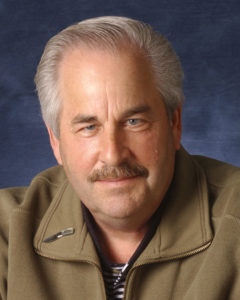
Phil may be best remembered for commissioning what is arguably the most important knife of the modern custom era: the King Tut Dagger Reproduction by fellow Hall-Of-Famer Buster Warenski.
Beginning in 1983 Phil coordinated the annual Art Knife Invitational, an intimate gathering of the world’s elite knifemakers in San Diego, who in turn offered their knives for sale to the world’s elite custom knife collectors. The show took about a 10-year hiatus but returned as a biennial event and continued to draw the elites worldwide. It continues under the direction of Phil’s daughter, Sandee.
For a time in the 1970s Phil shared his home with Hall-Of-Famer Gil Hibben. Hibben made knives in Phil’s garage, with Phil by his side. Later, with Phil in tow, Gil enjoyed an audience with a special fan of Hibben knives: Elvis Presley. Phil and Gil visited with Elvis until the wee hours, a meeting that remains the stuff of legend.
Phil’s vast knowledge of custom knives and also 19th-century dress bowies proved an invaluable source of information for many, including BLADE. Perhaps Phil’s most important contribution was his faithful patronage and support of the custom knife industry. He bought and collected the knives of many makers from the early 1970s on at a time when the industry needed such buyers/collectors desperately to survive. As a Hall-Of-Fame nominator noted, “Phil was the definition of a knife collector, always talking and promoting knives. Then he started his Art Knife Invitational and that changed the custom knife industry forever.”
Tony Bose (2019)
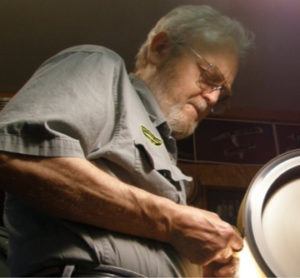
When Tony Bose first started building knives, he asked a maker to share a knife pattern with him. When the maker refused, Tony decided that whenever anyone asked him for a pattern he would give it to him, and he always has, sending patterns all over the world.
Few have done more in mentoring and teaching their fellow makers through instruction and by example than Tony, who is perhaps the world’s best-known contemporary custom maker of traditional slip joints. It’s never been his mission to simply make knives. Instead, he aspires to “bring knives back from the dead.”
His love of knifemaking began in 1972, when he made his first custom fixed blade from an industrial hack-saw blade. As he put it, “I’ve been trying to make a knife that I’m completely happy with ever since. It hasn’t happened yet.”
He worked for years perfecting his skills before pursuing a full-time custom knifemaking career in 1990. His impact was quickly felt when he won Best Folder at the 1994 East Coast Custom Knife Show and also at the 1995 BLADE Show.
In 1998, Tony began working as a custom collaborator with Case. Since 1999, among the knives he has designed for Case are collaborations of vintage patterns made in limited quantities on an annual basis. One such offering was the Arkansas Hunter, winner of the BLADE Magazine 2008 Collaboration of the Year.
Tony’s a crowd favorite at Case consumer events, knife shows and swap meets across the country, and he willingly shares his techniques with other makers to keep the art of making traditional knives alive for future generations. He’s also taught classes on knives and knifemaking at BLADE University during the BLADE Show, and for many years made and donated knives for silent auctions at BLADE Shows to raise money for the old National Knife Collectors Association.
This past year, Tony was awarded the fourth annual Aldo and Edda Lorenzi Award at the BLADE Show for his many contributions as a mentor to knifemakers worldwide.
Mel Pardue (2019)
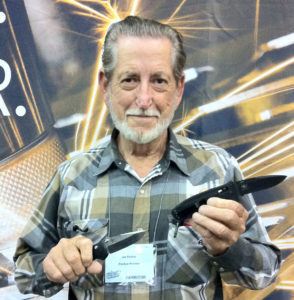
Mel Pardue made his first knife in 1952 and has fashioned them on a regular basis since 1956. A voting member of the Knifemakers’ Guild for almost four decades, he served on the Guild’s board of directors in various capacities for 14 of those years, the final 10 as vice president. He received the Ron Little Award in 1992 and is a past winner of the Guild’s Red Watson Friendship Award.
He is the first person without membership in the American Bladesmith Society to teach at the William F. Moran School of Bladesmithing, where he conducted classes on how to make folders. He has taught the same subject at the Batson Bladesmithing Symposium, and has held seminars and classes in the Pardue shop for over 40 years. His numerous designs for Benchmade Knives have been among the company’s most popular and best-selling models for many years.
In 2016, Mel was presented with the BLADE Show’s Aldo and Edda Lorenzi Award for his outstanding work in teaching and mentoring his fellow makers in the art of building knives.
As one nominator noted, “Mel exemplifies the pure definition of a custom knifemaker. He is a craftsman of the highest caliber who hand makes his world-renowned knives, one by one, without the use of modern technology. He embodies the highest level of personal and professional ethics.
In the nearly four decades I have known Mel, he has demonstrated a true respect for both fellow custom makers and unselfish dedication and love for his craft, sharing hard-gained knowledge and skills. He has helped dozens of up-and-coming knifemakers of all ages.”
Steve Shackleford (2019)

“If I were to start a knife magazine tomorrow, my first call would be to Steve Shackleford.”
So said Bruce Voyles, former publisher of BLADE magazine, during the BLADE Show 2019 induction of Steve Shackleford, into the Cutlery Hall of Fame. In keeping with the tradition of not announcing inductions in advance when the honoree is attached to BLADE, Shackleford’s newfound membership came as a surprise to BLADE‘s editor-in-chief.
But it should be no surprise that “Shack,” as he’s called around the BLADE offices, would join the ranks of the best and brightest in blades. Steve joined BLADE in 1985, when both he and the venerable magazine called Tennessee home. The U.S. Navy veteran showed up driving a car “with a big hole in the floor,” as Voyles recalled, and a willingness to capture an exciting moment in the custom and factory knife industry.
Ever since then, Steve continues to lead BLADE‘s editorial mission with a cool hand, vigor and a contagious appreciation for cutlery. A ubiquitous presence within the industry, there are few who don’t pass through his editorial conduit, even if they don’t know it at the time. There is a reason BLADE was and remains the world’s number one knife magazine, and that reason is Steve Shackleford.
For his championing of BLADE, knifemaking and knife enthusiasm, Steve is a welcomed addition to the Cutlery Hall of Fame.
Joe Keeslar (2020)
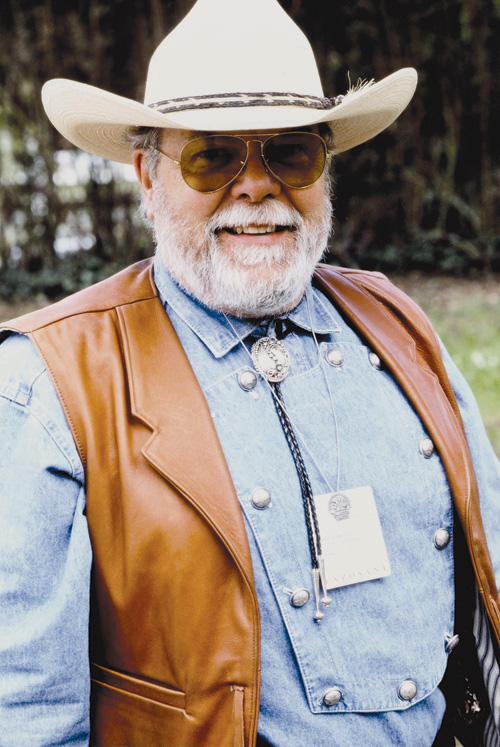
A resident of Almo, Kentucky, Joe has had an extensive, storied career in the American Bladesmith Society, earning his ABS master smith stamp in 1989. Known for his forged fixed blades, many in the brut de forge style, he also is noted for his beautiful handles with silver wire inlay and matching leather sheaths, the latter often adorned with conchos and other rich embellishments.
Joe joined the ABS board of directors in 1991, served as ABS president from 2003-07, and completed his second term as president in 2015. He has had a dramatic influence on bladesmithing in Europe, where he was chiefly responsible for the first modern hammer-in held in France. He is also a frequent demonstrator at the Thiers Knife Show, one of Europe’s largest knife shows, in Thiers, the knifemaking capital of France. He is the only American knifemaker to receive an honorary membership in the Confrerie du Couteau de Thiers, a French knifemaking organization.
As one nominator wrote, Joe is “the most effective maker in the USA to extend forged-blade activity in Europe,” and is the most active in spreading the ABS’s “high level of information.” He has taught knifemaking at the William F. Moran School Of Bladesmithing and at Haywood College, at hammer-ins in Alabama, Arkansas, North Carolina and Ohio, and at the first four renditions of BLADE University at the BLADE Show. He is author of the books Handles and Guards and Forging and Finishing the Brut de Forge Knife. He also is primarily responsible for the rapidly expanding ABS youth program, which holds an annual hammer-in at Smoky Mountain Knife Works.
According to another nominator, Joe “embodies the calm and consistent leadership, knifemaking skills, education and friendship that is so valuable to the entire world of knives.” According to another, “Joe has done more for the ABS than any person besides the late, great W.F. ‘Bill’ Moran.” Lastly, Keeslar was awarded the first annual Aldo and Edda Lorenzi Award at the 2015 BLADE Show for his many contributions as a mentor to bladesmiths worldwide.
Jim Sornberger (2020)

Calling Volcano, California, home, Jim is a veteran stock removal knifemaker known for his award-winning fixed blades and folders, among the former especially his ornate California-style dress bowies in exotic handle materials such as lapis lazuli and gold quartz.
According to a nominator, when Jim started building knives in 1970, there were only a handful of makers in northern California. As more people became interested in knives and Jim’s “knife family” grew, they experienced difficulty buying knifemaking supplies because no one on the West Coast sold them.
As a result, along with Bill Holt, Jim started H&S Supply in 1981. Cutlery Hall-Of-Famer Bob Loveless and Jim made sure H&S had the right-size steel for knifemaking, and when 154CM stainless steel became “unclean,” they helped bring in ATS-34 stainless so many West Coast makers would have it available. Jim and Bill helped support many of the makers who could barely make ends meet by selling them the steel on credit. In fact, Jim still has a bar of 154CM that Loveless gave him many years ago.
Circa 1980, along with a few others, Jim sponsored and organized the Bay Area Knife Collectors Association (BAKCA) Show, which went on to become the most successful club show on the West Coast. Jim would generously give up his table space to help makers get started, including his good friend and outstanding knifemaker in his own right, Stan Fujisaka.
In later years, Jim helped bring interest to the California-style dress bowie in gold work and engraving. He shared most everything he learned with other makers, helping many to learn the craft. He writes articles for KNIFE Magazine and has written for BLADE®, and also helped write BAKCA’s by-laws. For a number of years he served on The Knifemakers’ Guild board of directors, including as vice president.
Jay Hendrickson (2021)

Jay is an American Bladesmith Society (ABS) master smith who succeeded Cutlery Hall-Of-Fame member Bill Moran as ABS president in 1991—as a nominator noted, “a trying task to be sure, and Jay succeeded Bill very well.” The nominator went on to write Jay is a good bladesmithing teacher who has taught at many venues in the USA and France, and also served as director of the Moran Foundation for 10 years, helping to preserve Bill’s legacy.
Early on, Jay and Bill conducted a forging demonstration that was one of the longest running of all BLADE Show demos. The first installment was in 1987 on the sidewalk outside the show’s former Holiday Inn & Convention Center site in Knoxville, Tennessee, and continued at each succeeding BLADE Show in Knoxville and then at the Cobb Galleria in Atlanta until Bill passed away in 2006. Not only was it one of the BLADE Show’s longest running demos, it was also one of the most popular.
In 1995, Jay was presented with the ABS’s highest honor, the Don Hastings Award. The annual honor goes to an individual “who has performed outstanding service on behalf of the forged blade in the tradition of Don Hastings,” one of the founders of the ABS. In 2004, Jay won the William Wales Scagel Award, presented by the ABS to a bladesmith “for longtime service to promote the forged blade.” Another Cutlery Hall Of Famer, Scagel is considered the grandfather of custom knifemaking.
Jay was voted into the ABS Hall Of Fame in 2006 and a year later wrote the how-to guide, Introduction to Bladesmithing, with tips on how to forge various blade styles “exhibiting balance and aesthetic appeal,” how to understand the basic metallurgy of popular blade steels and more. Concluded the nominator, “Jay is a fine bladesmith, a fine teacher helping to preserve the art of bladesmithing, and a splendid ambassador of knives and knifemakers.”
Last but certainly not least, Jay forges magnificent fixed blades in the classic Moran style, including expertly ground bowies, camp knives, fighters, hunters and more, often in curly maple handles with intricate silver wire inlay, all accompanied by superb leather sheaths.
Beverly and Billy Mace Imel (2021)

Beverly and Billy Mace are the first pair of Cutlery Hall-Of-Famers ever to be inducted simultaneously. They also join A.G. and Goldie Russell as the only husband-and-wife team in the Hall.
Billy makes fantastic fixed blades yet is perhaps best known for his sleek daggers with stainless steel blades in clean, crisp grinds and slender handles in a variety of gorgeous materials. To augment that knifemaking talent is his many hours of service to The Knifemakers’ Guild.
“What can you say about those who have worked so many hours and years to help so many?” wrote a nominator. “Billy was the secretary of the Guild during a huge building phase of the longtime maker association. Every year many new applicants had to be processed. Those of us who sat on the Guild’s board of directors during many of those years can testify to the energy and effort Billy put forth. The heavy load of accounting, stopping his own work to help discuss an issue—and those issues were many—and still be able to arrive at the Guild Show venues two days early with his own knives and to help set up each show’s exhibition room was a remarkable achievement. I think Billy is a gold standard for the Cutlery Hall Of Fame in terms of working hard for others.”
Beverly, meanwhile, served with distinction for many years on the Guild board as the organization’s secretary-treasurer.
“You can’t mention Billy’s name without mentioning Beverly’s,” the nominator continued. “The Guild board of directors was a large wheel, with every director a spoke in that wheel, but it was Beverly who kept the wheel’s hub lubricated and in motion. She maintained the Guild’s records in perfect order, and if there was a question about something from the past, she either looked it up or could recall it from memory—often smack dab in the middle of a Guild business meeting.”
Beverly’s familiarity with and recollection of Guild bylaws was legendary. Indeed, anytime a Guild president was asked a question he didn’t know the answer to during a Guild business meeting, he would often turn from the microphone and say, “Beverly, do you know?” Invariably she did and more than a few members in attendance would smile and wink at each other as a result.
The nominator went on to state that he wanted the Cutlery Hall of Fame to step out of the mold and do something different in considering Billy and Beverly for enshrinement. “It would be honorable for us to induct both of the Imels as one,” he wrote. Enough sitting Hall Of Famers agreed and the Imels are now members of their august group.



